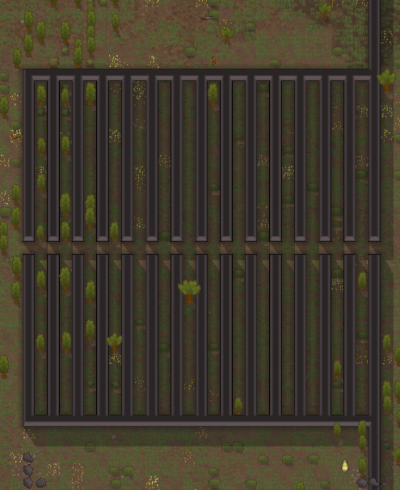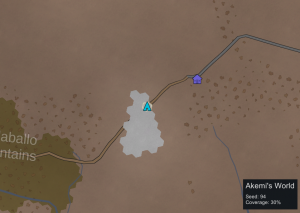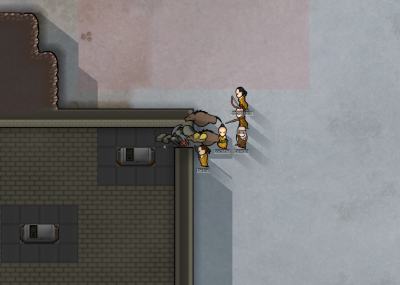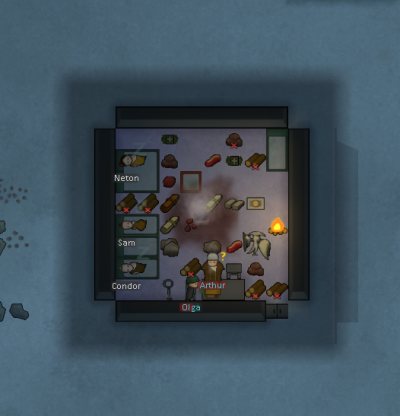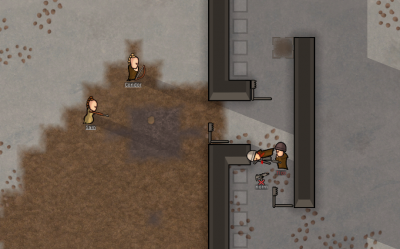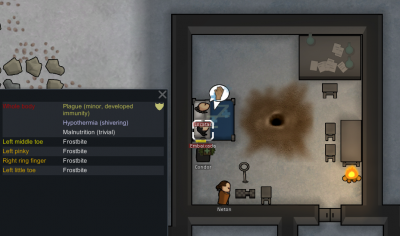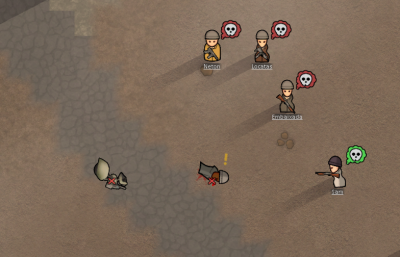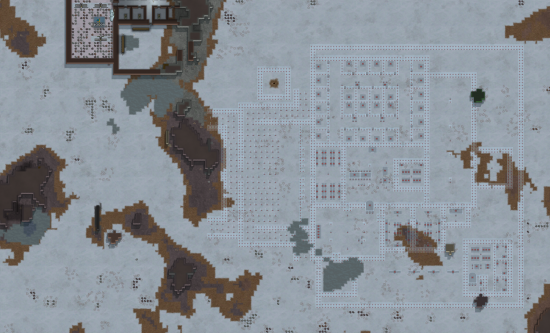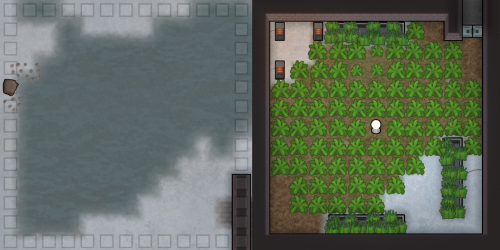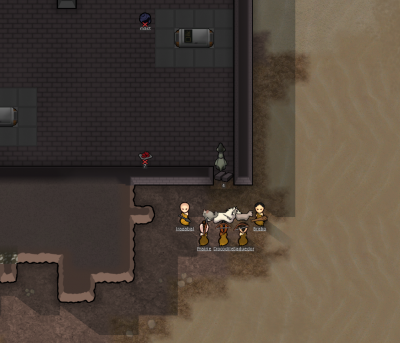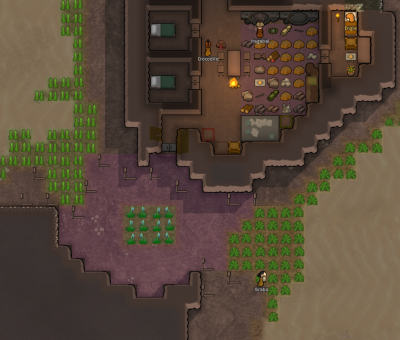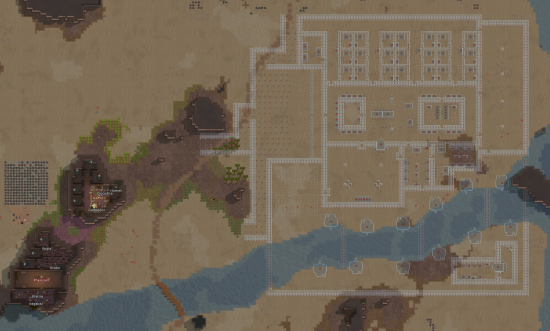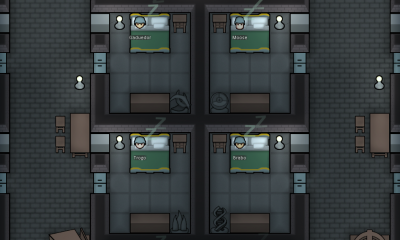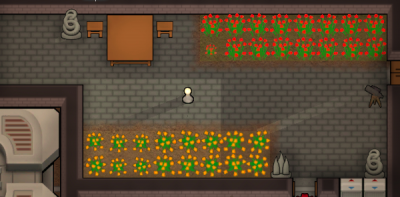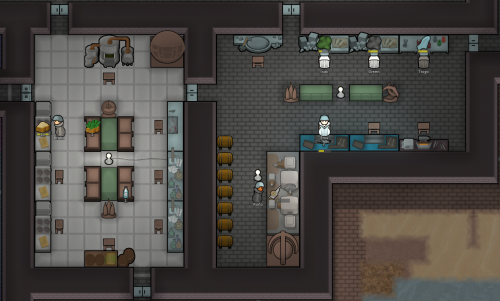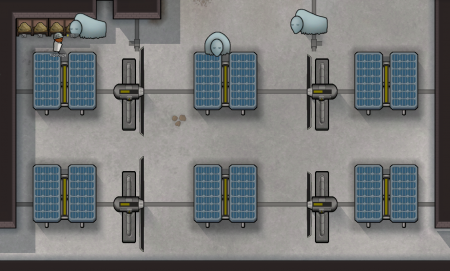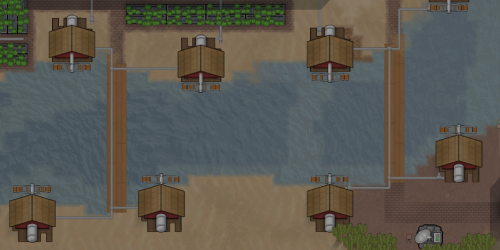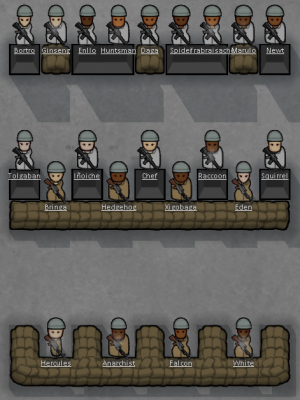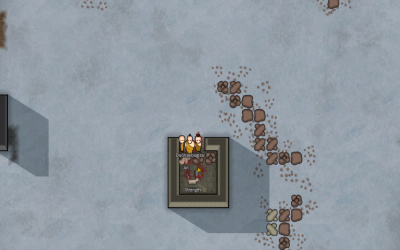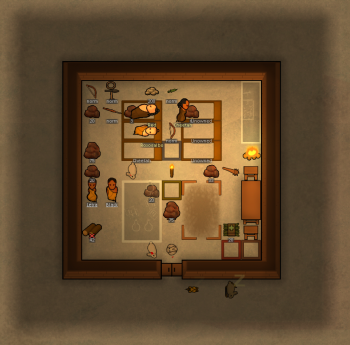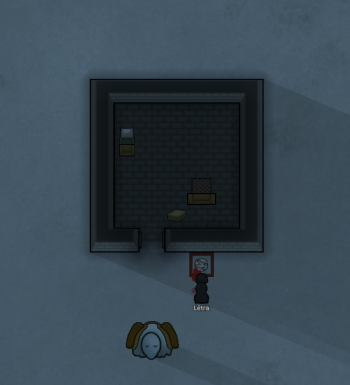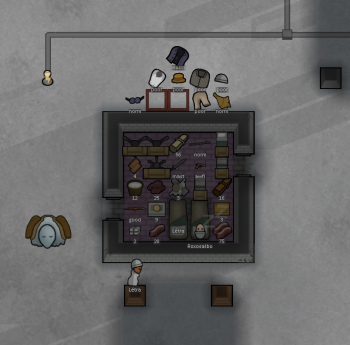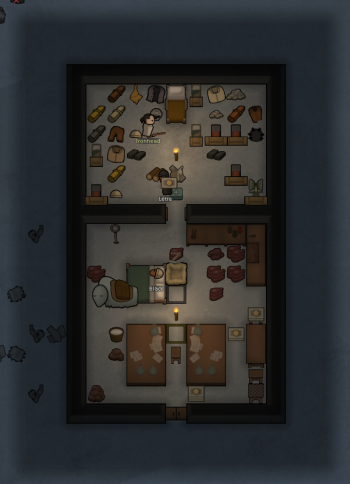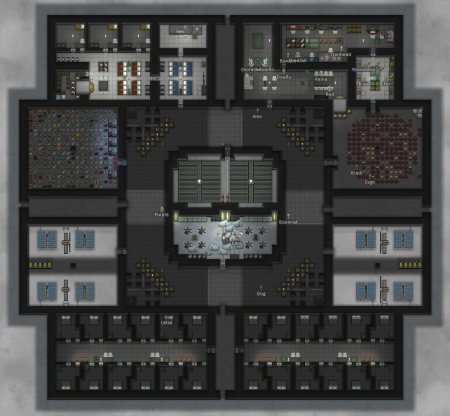Difference between revisions of "User:PigeonGuru/Archive"
PigeonGuru (talk | contribs) |
PigeonGuru (talk | contribs) |
||
| Line 413: | Line 413: | ||
[[File:crops.png|350px|thumb|center|Before a beach (left) and later a crop field (right).]] | [[File:crops.png|350px|thumb|center|Before a beach (left) and later a crop field (right).]] | ||
| − | = Colony building guide ( | + | = Colony building guide (pre-'restoration') = |
This guide is the ultimate go-to guide to building your base, for all stages of the game. | This guide is the ultimate go-to guide to building your base, for all stages of the game. | ||
| Line 419: | Line 419: | ||
== Base Types == | == Base Types == | ||
| − | There are different ways to build your base. | + | There are different ways to build your base. In all different designs one can opt to either predefine each room role or make modular rooms which are easier to expand but also less efficient. |
=== Superstructure base === | === Superstructure base === | ||
| − | + | A superstructure base is a base where everything or almost everything is in one large building rather than smaller separate parts. | |
| − | This is | + | This is the most common method to build bases. |
'''Pros''' | '''Pros''' | ||
| − | + | * Saves building materials and space. | |
| − | *Saves building materials and | + | * Easier to control temperature. |
| − | *More resistant against [[Events#Toxic_Fallout|toxic fallout]] | + | * Easier to defend against raids. |
| − | + | * More resistant against [[Events#Toxic_Fallout|toxic fallout]]. | |
'''Cons''' | '''Cons''' | ||
| − | * | + | * Geothermal vents and patches of deep water can limit the design and patches of soft sand will require [[moisture pump]]s before building, marshy terrain can just be covered with [[bridge]]s. |
| − | + | * Some areas might need to be unroofed to prevent cabin fever. | |
| − | * | + | * Some large hallways might be needed to help defend against raiders dropping on top. |
| − | * | ||
| − | === | + | === Separate structures base === |
Build everything in separated buildings, just like building a small town. | Build everything in separated buildings, just like building a small town. | ||
| − | + | It is easier for starting off, but it is overall more vulnerable, so usually does not scale as well into late game. | |
'''Pros''' | '''Pros''' | ||
| − | * | + | * Easier to avoid areas with building restrictions. |
| − | * | + | * Naturally gets rid of cabin fever. |
| + | * Naturally offer areas in between buildings to fight raiders that drop on top. | ||
'''Cons''' | '''Cons''' | ||
| − | *Requires more space and building materials overall | + | * Requires more space and building materials overall. |
| + | * Harder to control temperature. | ||
| + | * Harder to defend against most raids. | ||
| + | * Vulnerable to [[Events#Toxic_Fallout|toxic fallout]]. | ||
=== Mountain base === | === Mountain base === | ||
For mountainous maps where you have less space to build, you can opt to dig inside the mountains instead. | For mountainous maps where you have less space to build, you can opt to dig inside the mountains instead. | ||
| + | |||
| + | Also very easy to start off, used to be the most popular kind of base but now depending on how bad the [[Infestation]]s are it can be good or impossible late game. | ||
'''Pros''' | '''Pros''' | ||
| − | * | + | * Saves a lot of building materials. |
| − | * | + | * Easier to control temperature. |
| − | *Immune to | + | * Easier to defend against raids. |
| − | + | * More resistant against [[Events#Toxic_Fallout|toxic fallout]]. | |
| + | * Free, beautiful [[Smooth stone|floor]] and walls. | ||
| + | * Immune to sieges and raiders dropping on top. | ||
'''Cons''' | '''Cons''' | ||
| − | * | + | * Infestations inside can be impossible to deal with. |
| − | * | + | * Cabin fever can be a real problem. |
| − | + | ||
| + | == Base Structures == | ||
| + | |||
| + | Different structures suit the different needs of your colony. Most maps generate with ruins around, sometimes just walls and others are squares/rectangles just missing some filling sections. These if conveniently located can work perfectly at starting points reducing considerably the initial workload of characters with low level skills and reducing the beginning stage stress when you still have nothing. | ||
| + | |||
| + | === Warehouse === | ||
| + | |||
| + | The warehouse is a room with a stockpile. The first room we need to build due to the "outdoors" deterioration on items if left in the open. It is not an official [[room roles|room role]]. | ||
| + | |||
| + | Later in the game the warehouse is usually the biggest room in the base. It should be covered by [[orbital trade beacon]]s so you can sell your stuff to trade ships. | ||
| + | |||
| + | The [[electric crematorium]] and [[electric smelter]] may be placed here, if you store corpses, tainted clothes, useless guns and steel slag chunks inside, to speed up burning/melting them. Also, if you making [[chemfuel]] with [[wood]] you may place the [[biofuel refinery]] here. | ||
| + | |||
| + | It does not need to be impressive or temperature controlled and should be built close to the workshop to minimize travel times. | ||
| + | |||
| + | === Bedrooms === | ||
| + | |||
| + | [[File:bedrooms.png|400px|thumb|right|Example of bedrooms. With table and chairs right outside.]] | ||
| + | |||
| + | Bedrooms are rooms with only one bed. | ||
| + | |||
| + | Only couples like to share a room, and all sleeping colonists will get disturbed by non-lovers walking about in the same room while they sleep, so once you have the resources you should upgrade to individual bedrooms for each colonist or couple. It is recommended to have [[double bed]]s in all rooms since they have better impressiveness, and couples can use them should they strike up love. | ||
| + | |||
| + | Good bedrooms give good mood modifiers so they should have plenty of art, good flooring and high-quality furniture. It should be temperature controlled for better moods. [[Dresser]]s and [[end table]]s are recommended in bedrooms to increase the comfort of the bed. [[Royal bed]]s are particularly good to have in bedrooms if you can afford it. | ||
| − | + | Colonists like to eat as soon as they wake up, but do not place table and chairs inside the bedrooms or colonists will use other colonists' tables at night and cause 'Disturbed sleep' penalties, instead bedrooms should be built close to dining rooms. Still, some people choose to build tables and chairs inside for aesthetic reasons. | |
| − | + | === Barracks === | |
| − | The | + | The barracks is a room with multiple beds. |
| − | + | They are usually a good option early-game when resources are limited, or during late-game to deal with an overflow of people. Overall, it is better to have separate bedrooms since barracks give a lower mood modifier and cause a lot of 'Disturbed sleep' penalties. | |
| + | |||
| + | Good barracks give good mood modifiers so they should have plenty of art, good flooring and high-quality furniture. It should be temperature controlled for better moods. [[Dresser]]s are a very good addition to barracks since they increase the comfort of many beds at once. | ||
| − | + | Colonists like to eat as soon as they wake up, but do not place table and chairs inside the barracks or colonists will use the tables at night and cause 'Disturbed sleep' penalties, instead barracks should be built close to dining rooms. | |
=== Dining room === | === Dining room === | ||
| − | Dining rooms, | + | [[File:dinningroom.png|400px|thumb|right|Example of combined recreation/dining room. The middle is unroofed to get rid of cabin fever and to accommodate a telescope.]] |
| + | |||
| + | Dining rooms are rooms with table and chairs for colonists to eat in. | ||
| + | |||
| + | It is usually a good idea to have the main dining room near the food storage so your colonists will actually use the dining room, instead of eating on the floor. | ||
| + | It is also a good idea to have smaller dining rooms near colonists' bedrooms or they might eat their breakfast on the floor since colonists tend to go to bed with food and eat as soon as they wake up. | ||
| + | |||
| + | In big bases, dining rooms can be partially unroofed to get rid of cabin fever since colonists do not mind eating in hot or cold rooms. | ||
| + | |||
| + | Good dining rooms give good mood modifiers so they should have plenty of art, light, good flooring and high-quality furniture. It does not need to be temperature controlled. [[Nutrient paste dispenser]]s are very useful in dining rooms to ensure that nobody needs to eat raw food, they are usually placed half in the dining room and half in the freezer. | ||
| + | |||
| + | Dining rooms can be combined with recreation rooms. | ||
| + | |||
| + | === Recreation room === | ||
| + | |||
| + | The recreation room is a room with sources of [[joy]]. | ||
| + | |||
| + | Colonists get bored of using the same joy source repeatedly, so you should have as many joy sources as possible in the recreation room. | ||
| + | |||
| + | In the early game, all you need is a [[horseshoes pin]] and a [[chess table]]. During mid-game you can add a [[poker table]], a [[billiards table]] and a [[tube television]], then upgrade it to a [[flatscreen television]]. Later, buy a [[megascreen television]] and a [[telescope]] from traders. | ||
| + | |||
| + | In big bases, recreation rooms can be partially unroofed to get rid of cabin fever since colonists do not mind playing in hot or cold rooms. | ||
| + | |||
| + | Good recreations rooms give good mood modifiers so they should have plenty of art, light, good flooring and high-quality furniture. It does not need to be temperature controlled. | ||
| + | |||
| + | Recreation rooms can be combined with dining rooms. | ||
| + | |||
| + | === Courtyard === | ||
| + | |||
| + | [[File:Courtyard.png|400px|thumb|right|Small courtyard that serves both as a dining room and recreation room.]] | ||
| + | |||
| + | You may consider building an unroofed courtyard in the center of your base where colonists can get some fresh air. It is not an official [[room roles|room role]]. | ||
| − | + | You can use it as a common area, putting joy items and dining tables for colonists to use, making the courtyard behave exactly the same as an unroofed dining/recreation room. It may also be used as a place to put your [[mortar]]s as putting them in the middle helps negate their blind spots, or [[transport pod]]s. This is better if it is a separate unroofed area as they are not beautiful to look at. | |
| − | + | {{clr}} | |
| − | === | + | === Freezer === |
| − | + | [[File:freezer.png|400px|thumb|right|Example of a freezer with protected coolers. Corpses of important dead colonists are frozen inside for future [[resurrector mech serum|resurrection]].]] | |
| − | + | The freezer is room with a stockpile that is kept cold by [[cooler]]s. It is not a official [[room roles|room role]]. | |
| − | + | The freezer is where you to keep your perishables that would otherwise spoil in the storage like food and corpses. Because you will be storing your harvests here, it is wise to position this room close to your plantations to reduce hauling jobs, with the doors pointing toward your growing zones. It should be covered by [[orbital trade beacon]]s so you can sell your food to trade ships. | |
| − | + | This is usually the second biggest room in the base. [[Nutrient paste dispenser]]s are usually placed half in the dining room and half in the freezer. | |
| − | + | Even though food freezes at {{Temperature|0}} you should have your freezer at least set at {{Temperature|-5}} since it will lose temperature whenever a colonist comes in. It is common to make airlocks in the entrance of the freezer to reduce that temperature exchange. It is also common to make the freezer with double walls to increase insulation. The freezer is vulnerable to [[Events#Solar Flare|solar flares]]. | |
| − | + | To save power it is a good idea to have the [[cooler]]s set to different temperatures. For example, if two [[cooler]]s are set to {{Temperature|-5}} then both will always consume power, but if a [[cooler]] is set to {{Temperature|-5}} and another is set to {{Temperature|-8}} then the first will only consume power during hotter times when the second is not able to keep the temperature bellow {{Temperature|-5}} alone. | |
| − | + | [[Cooler]]s placement is of crucial importance as these devices have a very low HP, making them the weakest point in a wall from where raiders would break in easily and most likely ignite your food supply. Because of this, one of the best ways to keep your freezer away from harm is to place the coolers in the inside unroofed, or of course, wall off the coolers too. | |
| − | + | [[Butcher spot]]s, [[butcher table]]s and [[crafting spot]]s can be placed inside the freezer to butcher corpses, make [[kibble]] and make [[smokeleaf joint]]s, since the work to make those is so small and the ingredients are in the freezer your colonists might as well do it there. However, for mass production, it is better to have it close but outside the freezer due to the work speed penalty. | |
| − | + | It does not need to be impressive and should be built close to dining rooms and kitchens. | |
| − | + | === Kitchen === | |
| − | + | The kitchen is a room with a stove or a [[butcher table]]. | |
| − | [[ | + | The kitchen is where your colonists turn raw food into meals. The room should be clean to avoid [[ailments#food poisoning|food poisoning]], so the [[butcher table]] may be placed nearby in a different room instead since it creates a lot of filth. |
| − | + | Besides stoves, the kitchen should include chairs, light and [[sterile tile]]s. You might want to add a little vegetable stockpile inside to save travel time, as plants take a while to spoil. Not flooring the kitchen can be a better option if you lack sufficient janitors, as dirt floors have less of an impact on both cleanliness and beauty than the dirt tracked into the kitchen, unless if you kitchen is full of blood instead of dirt. | |
| − | + | Since the kitchen is placed near the freezer, some crafting stations which include plants ingredients may be also placed in here. The [[brewery]] and [[drug lab]] are good choices and if you do place them here you should also add [[tool cabinet]]s and little stockpiles for [[hops]], [[smokeleaf leaves]], [[psychoid leaves]] and [[neutroamine]]. Also, if you making [[chemfuel]] with food you may place the [[biofuel refinery]] here. | |
| − | + | It does not need to be impressive, but it is usually a good idea to add a little art since colonists tend to stay there for a long time. It should be temperature controlled for better working speed. | |
| − | + | Zone out colony animals. | |
| − | |||
| − | |||
| − | |||
| − | === | + | === Workshop === |
| − | + | [[File:kitchenworkshop.png|500px|thumb|right|Example of a kitchen and workshop. Art keep people happy while working.]] | |
| − | + | The workshop is a room with crafting stations. | |
| − | A | + | The workshop is where your colonists turn raw materials into advanced products. Besides crafting stations, the workshop should include chairs, light and [[tool cabinet]]s. A lot of different little materials stockpiles may be placed inside to save travel time. |
| − | + | Early game crafting stations include the [[stonecutter's table]], [[sculptor's table]], [[hand-tailoring bench]] and [[fueled smithy]]. Mid game crafting stations include the [[machining table]], as well as the electric versions of [[hand-tailoring bench]] and [[fueled smithy]]. Late game crafting stations include the [[fabrication bench]]. | |
| − | + | The [[brewery]], [[drug lab]], [[biofuel refinery]], [[electric crematorium]] and [[electric smelter]] may also be placed here. | |
| − | + | It does not need to be impressive, but it is usually a good idea to add a little art since colonists tend to stay there for a long time. It should be temperature controlled for better working speed. | |
| − | + | It should be built close to storage. | |
| − | + | === Laboratory === | |
| − | + | The laboratory is a room with a [[simple research bench]] or a [[hi-tech research bench]]. | |
| − | + | Research speed is affected by the cleanliness of the room which is why it might be worth making a separate room for it. It should be isolated to avoid other people walking in dirt. | |
| − | + | Besides the research bench, the laboratory should include a chair, light and [[sterile tile]]s. After you get the [[hi-tech research bench]] you can also get a [[multi-analyzer]]. | |
| − | + | It does not need to be impressive, but it is usually a good idea to add a little art since colonists tend to stay there for a long time. It should be temperature controlled for better working speed. | |
| − | + | Zone out colony animals. | |
=== Hospital === | === Hospital === | ||
| − | |||
| − | + | [[File:smallhospital.png|310px|thumb|right|Example of small hospital.]] | |
| − | + | The hospital is a room with a medical bed. It is a place specialized in treating your colonists. If you do not have one, colonists will be treated in bedrooms. The room should be clean to avoid [[infection]]. | |
| − | [[ | + | In early-game all you need is [[floors]], [[bed]]s and a light source. During midgame you should replace your floor with [[sterile tile]]s and your beds with [[hospital bed]]s, and add [[vitals monitor]]s. All these will increase treatment quality. |
| − | |||
| − | Store | + | Store medicine in or near your hospital so your doctors can quickly patch up your colonists. |
| − | + | Good hospitals give good mood modifiers so they should have plenty of art and high-quality furniture. It should be temperature controlled for better moods and to prevent heatstroke or hypothermia from visitors. Since injured colonists will likely spend a lot of time in the hospital it is a good idea to add televisions which they can watch while in bed. If you do not have televisions, other colonists will go to the hospital to cheer them up to provide [[joy]]. | |
| − | + | It should be built close to the base entrance for quicker rescue. | |
| − | + | Zone out colony animals. | |
| − | === | + | === Armory === |
| − | + | The armory is a room with a stockpile for weapons and armor. It is not an official [[room roles|room role]]. | |
| − | + | Often your colonists need to change their guns and gear to better fight different kinds of raids. Having an armory helps to keep your gun and gear stock under control and puts them in a more accessible position for your colonists to grab them quickly. | |
| − | + | It does not need to be impressive, nor does not need to be temperature controlled. | |
| − | + | It should be built close to your defenses for quicker reaction to raids, and should also be far away from the prison. | |
| − | === | + | === Barn === |
| − | + | [[File:tamingbarn.png|250px|thumb|right|Example of taming barn. Even [[Megaspider]]s may be tamed if they show up as an [[events#herd migration: (animal)|animal herd]] but you will need to beat them down and bring them in to have time to tame them and do it safely.]] | |
| − | + | The barn is a walled area with [[animal sleeping spot]]s, [[animal sleeping box]]s or [[animal bed]]s. | |
| + | |||
| + | Barns help ensure that hauling animals will go back to your base at night for safety and that fragile animals will be isolated from predators. They are also used to ensure that animals products will drop near your base for quicker hauling. | ||
| + | |||
| + | They should include stockpiles of [[hay]] or [[kibble]] for the animals, if they are placed outside they should be in a [[shelf]] to avoid deteriorating. Since animals go back to their boxes or bed for healing it might be a good idea to store medicine near your barn for quicker patching up, again if placed outside they should be in a [[shelf]]. | ||
| + | |||
| + | Sometimes, it is good to have a small separated barn to bring in wild animals that you want to tame. Wild animals might go away or die for many different reasons, but if you keep them in an isolated room with food they will stay there forever. A good example is an [[events#herd migration: (animal)|animal herd]] passing through the area. You will not have time to tame them, but you can beat them down and bring them to your base and have all the time you need to tame them. Also prevents them from causing damage if the taming fails. | ||
| + | |||
| + | It does not need to be impressive, indeed it is better to not put down floors to avoid animal filth. It does not need to be indoors but you might want to at least partially roof it in case a [[Events#Toxic_Fallout|toxic fallout]] happens. It does not need to be temperature controlled unless if your animals cannot handle the local temperature. | ||
| − | + | It can be combined with outdoors rooms, like your power supply area. It should be built close to freezer or warehouse. | |
=== Prison === | === Prison === | ||
| − | [[File: | + | The prisons is the place where you put your captives of war. Better prisons make it easier to recruit people. Still, they are not consistently used, so one should consider how much effort and resources should be invested in it. During mid-late game, prisoners without immediate use can be kept for free inside [[cryptosleep casket]]s instead. |
| + | |||
| + | Basic features: | ||
| + | |||
| + | * Enclosed by walls. | ||
| + | * [[Bed]]s or [[sleeping spot]]s. | ||
| + | * Safe temperature. | ||
| + | |||
| + | [[File:fullprison.png|400px|thumb|right|Example of prison. The hospital/barracks gives a better mood than the cells and have access to a [[nutrient paste dispenser]] but the prisoners in cells are less likely to try to escape.]] | ||
| + | |||
| + | Good mood features: | ||
| + | |||
| + | * Light source. | ||
| + | * [[Floors]]. | ||
| + | * Table and chairs. | ||
| + | * Art. | ||
| + | * Comfortable temperature. | ||
| + | * [[Dresser]]s and [[end table]]s. | ||
| + | * [[Psychic emanator]]. | ||
| − | + | Convenience features: | |
| + | |||
| + | * Food stock. | ||
| + | * Medicine stock. | ||
| + | * Uniform stock. | ||
| + | * [[Nutrient paste dispenser]]. | ||
| − | + | Medical features: | |
| − | + | * [[Sterile tile|Sterile floor]]. | |
| + | * [[Hospital bed]]. | ||
| + | * [[Vitals monitor]]. | ||
| − | + | Safety features: | |
| − | + | * Isolated from the rest of the base, but not close to the map edges. | |
| + | * Isolated from any potential weapons, even [[wood]] and [[beer]]. | ||
| + | * Doors connected to an empty walled area, possibly guarded by [[Mini-turret|turrets]]. | ||
| − | + | Prisons can have the following rooms: | |
| − | + | ==== Prison barracks ==== | |
| − | + | Barracks are rooms with multiple prisoner beds. | |
| − | + | They are cheaper than cells and allow for features that are unreasonable to have in every single cell. The barracks mood modifier is lower than the cell but the barracks usually provides the 'Spacious interior' modifier and better dining room modifier, so they arguably offer better mood than cells since prisoners do not get 'Disturbed sleep' penalties. However, if a [[Events#Prison break|prison break]] happens all prisoners in the same barracks will break out together. | |
| − | === | + | ==== Prison cells ==== |
| + | |||
| + | Cells are rooms with a single prisoner bed. | ||
| − | + | Cells offer only slightly better mood improvement than barracks and usually are much more limited in what they can have. The major advantage of cells is that if a [[Events#Prison break|prison break]] happens, not all prisoners in nearby cells will join. They also prevent fights between prisoners. | |
| − | + | If you are lacking space for prisoners, a colonist bedroom can be temporarily turned into a cell. | |
| − | === | + | ==== Prison hospital ==== |
| − | + | The prison hospital is a room with medical prisoner beds. It is not an official [[room roles|room role]]. | |
| − | |||
| − | |||
| − | + | Prisoners often first enter your prison injured, so having a proper prison hospital can help avoid unnecessary deaths and infections. They are like a regular hospital attached to the rest of your prison, however, you do not need to have televisions in it since prisoners are not affected by [[joy]]. | |
| − | + | The prison hospital does not need to be a separated room only for healing. It can be the barracks but with medical features. | |
| − | === | + | ==== Prison freezer ==== |
| − | [[ | + | The prison freezer is a room with a stockpile kept cold by [[cooler]]s inside the prison. It is not an official [[room roles|room role]]. |
| − | + | For storing stocks of food and [[herbal medicine]] to prevent spoilage. If you have a [[Nutrient paste dispenser]] you can place half of it and all the [[hopper]]s inside. | |
| − | === | + | === Tomb === |
| − | + | The tomb is a room with [[sarcophagus|sarcophagi]]. | |
| − | + | Not the most important of the rooms, but colonists do go visit sarcophagi or graves filled with dead colonists for [[joy]] so you might want to give a nicer room for them to do that. | |
| − | |||
| − | |||
| − | + | It does not need to be impressive or temperature controlled and can be built anywhere. | |
| − | == | + | == Production == |
| − | + | You will need fields, buildings and animals to provide the raw materials that your colony needs. | |
| − | === | + | === Crop fields=== |
| − | + | [[File:biggreenhouse.png|300px|thumb|right|Example of greenhouse. The top [[sun lamp]] has 24 [[hydroponics basin]]s which is the maximum possible. They are particularly important in cold [[biome]]s.]] | |
| − | + | ''See also: [[Food production]] | |
| − | + | Crop fields are growing zones or [[hydroponics basin]]s, designated to the desired plant type. | |
| − | + | Depending on the soil fertility different plants might generate the best productivity: | |
| + | *[[Potatoes]] and [[berries]] perform better in poor soil. | ||
| + | *[[Rice]] and [[corn]] perform better in rich soil. | ||
| − | + | Crop fields do need to be protected from raiders or they will burn them down, which can be hard on harsh [[biome]]s where the fertile soil might be far away from your base; however, crop fields are not particularly important structures, so they need not be given priority in defense. | |
| − | + | They also need to be protected from animals, both wild and domestic. Crop fields are vulnerable to [[events#blight|blight]]s and [[Events#Toxic_Fallout|toxic fallout]]. | |
| − | + | Ideally, they should be made near your freezer. | |
| − | + | === Greenhouses === | |
| − | + | Greenhouses are a protected version of crop fields. They are growing zones or [[hydroponics basin]]s in a temperature controlled environment. Since they are indoors, they also require [[sun lamp]]s. | |
| − | + | They are much more expensive than fields but they allow crops to grow all year in cold environments. It is common to make airlocks in the entrance of the greenhouse to reduce temperature exchange and make it with double walls to increase insulation. They are vulnerable to [[events#blight|blight]]s and [[Events#Solar Flare|solar flares]]. | |
| − | + | To save power it is a good idea to have the [[heater]]s set to different temperatures. For example, if two [[heater]]s are set to {{Temperature|21}} then both will always consume power, but if a [[heater]] is set to {{Temperature|21}} and another is set to {{Temperature|24}} then the first will only consume power during colder times when the second is not able to keep the temperature above {{Temperature|21}} alone. | |
| − | + | Ideally, they should be made near your freezer. | |
| − | + | === Mines === | |
| − | + | Mines are areas your colonists go to mine. | |
| − | + | If you are mining the stones in the outside layer of a mountain then you got nothing to worry about. However, if you decide to mine deep inside a mountain, then you need to build a proper mine as you mine out the stones to avoid rocks collapsing on top of your colonists. Wood is usually a good cheap material to use to make mines. | |
| − | [[ | + | Another thing to worry about when making mines is [[infestation]]s. You can build doors inside your mine to create choke points where you can fight the insects and help your colonists running away. Alternatively, you can fill up the whole mountain with wood so [[infestation]]s can not happen at all. |
| − | + | === Drilling rooms === | |
| − | + | [[Deep drill]]s are often placed far away from your base and similar to mines that they can also cause [[infestation]]s. So you might want to enclose the area with walls and doors to create choke points where you can fight the insects and prevent predators from attacking isolated miners. | |
| − | + | === Animals === | |
| − | + | {{main|Animals}} | |
| − | + | Animals have a variety of uses, therefore herding some of them in your barn can be very helpful. Of course all animals can be used for different reasons, but it is worth mentioning some of them because they are either particularly useful or versatile: | |
| − | + | * Produce raw food: eggs, milk or meat. [[Chicken]], [[Cow]], [[Dromedary]], [[Muffalo]], [[Pig]]. | |
| + | * Produce textiles: leather or wool. [[Chinchilla]], [[Alpaca]], [[Dromedary]], [[Muffalo]], [[Megasloth]]. | ||
| + | * Produce fuel: chemfuel. [[Boomalope]]. | ||
| + | * Haul animals. [[Pig]], [[Wild boar]], [[Elephant]], [[Megasloth]]. | ||
| + | * Pack animals. [[Alpaca]], [[Dromedary]], [[Muffalo]], [[Elephant]]. | ||
| + | * Combat animals. [[Wild boar]], [[Elephant]], [[Megasloth]]. | ||
| − | + | [[Chicken]], [[Cow]], [[Chinchilla]], [[Alpaca]] and [[Boomalope]] are quite profitable. | |
| − | + | [[Pig]], [[Wild boar]], [[Elephant]] and [[Megasloth]] are the only ones that can graze and haul. | |
| − | + | [[Dromedary]], [[Muffalo]], [[Elephant]] and [[Megasloth]] are really versatile. | |
| − | + | One should notice that combat animals are much better at defending caravans than defending your base. | |
== Power == | == Power == | ||
| + | |||
| + | Your colony needs power, so you should provide generators and protect them from attacks. Therefore, it is better to place them inside your base walls. Your options for power generation include the following. | ||
=== Solar power === | === Solar power === | ||
| − | [[Solar generator]]s provide power only during the day. It provides 1700W | + | [[Solar generator]]s provide power only during the day. It provides 1700W during summer peak hours near the equator, but little to none during winter near the poles. They are particularly good to power up [[sun lamp]]s since these only consume power during the day. They should be used together with [[battery|batteries]] so you may still have power during the night. They are vulnerable to [[events#Eclipse|eclipse]]s. |
=== Wind power === | === Wind power === | ||
| − | [[ | + | [[File:windsolar.png|450px|thumb|right|Example of solar-wind setup. It is more efficient to place the wind turbines facing each other with their exclusion zones overlapping.]] |
| − | It requires plenty of open space for maximum efficiency | + | [[Wind turbine]]s provide unstable power throughout the day. It can provide up to 3000W, but it usually gives less than that. They should be used together with batteries to make up for the instability. |
| + | |||
| + | It requires plenty of open space for maximum efficiency and any obstacles can easily reduce efficiency. To prevent trees from growing and obstructing the turbines, you may grow crops underneath the turbines or fill in the gaps with solar generators. | ||
=== Fueled generation === | === Fueled generation === | ||
| − | You can get the [[wood-fired generator]] which runs on wood, or the [[chemfuel powered generator]] which runs on [[chemfuel]] | + | You can get the [[wood-fired generator]] which runs on wood, or the [[chemfuel powered generator]] which runs on [[chemfuel]]. Both provide a constant 1000W of power, so it is a good idea to have some of these as a backup power source, or even as your main source in biomes that are loaded with trees. Since they are stable they do not require batteries. |
| − | Chemfuel is significantly more efficient than wood, so once you research the [[refinery]] it | + | Chemfuel is significantly more efficient than wood, so once you research the [[biofuel refinery]] it is better to refine wood into chemfuel before using it as fuel. |
| + | |||
| + | They are useful complementing [[solar generator]]s during winter in cold biomes, since [[solar generator]]s does not work in winter near the pole. | ||
==== Boomalope setup ==== | ==== Boomalope setup ==== | ||
| − | + | 3 [[Boomalope]]s generate enough chemfuel to run 4 generators. It is easy to run an entire base on that setup since they generate more energy than you spend to grow food for them, specially if your colony is somewhere they can graze. | |
| − | |||
| − | |||
==== Infinite chemreactor setup ==== | ==== Infinite chemreactor setup ==== | ||
| − | Infinite | + | [[Infinite chemreactor]]s generate enough chemfuel to run a generator, which in turn generates more than enough power to run the chemreactor. |
| − | + | It is overall an amazing setup but [[infinite chemreactor]]s are hard to come by, so you should not expect to run your whole base on that. | |
=== Geothermal power === | === Geothermal power === | ||
| − | [[Geothermal generator]]s constantly gives 3600W of power after being built on a steam geyser | + | [[Geothermal generator]]s constantly gives 3600W of power after being built on a steam geyser. |
| + | |||
| + | While powerful, it has one big issue; you can not choose where the steam geysers will be, so if you do not have one inside your base you need to cover them with walls to protect them. If you wall off your [[geothermal generator]] completely with double walls the raiders will ignore it most of the time. They will, however, sometimes randomly attack your walls, but it is really unlikely that they will destroy both walls and reach the generator. As it can randomly break down, you should still add doors so colonists can enter, better to use stone doors because they are durable and raiders can not ignite it. | ||
| + | |||
| + | Another problem is that raiders will likely destroy the conduits connecting the generator to your base, so build multiple conduit lines to reduce the likelihood of raiders completely severing the connection. Also, even though they do not need batteries, you should build some in case it gets disconnected during a raid. | ||
| + | |||
| + | Note that they generate plenty of heat, so they should be unroofed or they will catch on fire. | ||
| + | |||
| + | === Watermill generator === | ||
| − | + | [[File:watermills.png|500px|thumb|right|Example of watermills setup. It runs a big base without batteries.]] | |
| − | + | The [[watermill generator]] constantly provides 1100W of power but has to be placed next to rivers. So you must include the river inside your base design. However, that is usually quite simple since rivers tend to cross the whole map edge to edge. It does mean you will have to wall off a larger area, but it is well worth it since the watermill is quite reliable and lots of them can be placed on the same river. | |
| − | It is | + | It is quite easy to run a base just on watermills but of course, rivers are not available in every map. Since they are stable they do not require [[battery|batteries]]. |
| − | === | + | === Vanometric power cell === |
| + | |||
| + | A [[vanometric power cell]] constantly provides 1000W of power and can be placed anywhere. Like the [[infinite chemreactor]], they are hard to come by, so you should not expect to run your whole base on that. | ||
| − | + | They are particularly good for starting off new bases, or sometimes powering isolated objects such as [[deep drill]]s. | |
| − | |||
| − | |||
| − | === Power | + | === Power storage === |
| − | + | [[Battery|Batteries]] store surplus power. They are recommended for when you rely on power sources that are not constant, such as wind or solar power. They allow for power storage during times of excess to be used during times of demand. For instance, this makes them useful to store spare power generated during the night from fueled generators in order to supply [[sun lamp]]s during the day. | |
| − | + | Not having batteries is also beneficial, if you have reliable power sources, since it almost nullifies the [[events#zzztt...|short circuit]] event, igniting a little fire instead of causing a huge explosion. | |
| − | + | Batteries need to be placed under a roof to prevent short-circuits during rain and should be placed indoors to protect them from external threats. Connect them to the grid via switches and shut off part of them after they are filled to reduce the impact of short circuits and have back up batteries in case of emergency. | |
| − | |||
| − | |||
| − | |||
| − | |||
| − | === | + | === Power network === |
| − | + | It is not a good idea to have just one conduit spanning the entirety of your base. While it saves materials, short circuits or other events can create breaks that can disconnect entire parts of your base from power. Instead, build a network with redundant pathways so that the grid will continue to function even if there is a break. | |
| − | + | Also, it is better to split the power network of your base. Having more than one power network makes power management harder but the [[events#zzztt...|short circuit]] event will be much smaller since it will not affect your whole base and all your power reserves. | |
== Defenses == | == Defenses == | ||
| + | |||
{{main|Defense structures}} | {{main|Defense structures}} | ||
{{see also|Defense tactics}} | {{see also|Defense tactics}} | ||
| − | Unless you | + | Unless you are playing on peaceful difficulty, you will eventually encounter major threats, so you will need to prepare your defenses for that. |
| + | |||
| + | More defensive buildings can be seen on [[defense structures]]. Here, we show only the basics. | ||
| − | + | === Static cover === | |
| − | + | [[File:cover.png|300px|thumb|right|Example of different ways to setup static cover. In this example the white colonists can only shoot 90 degrees in front of them while the brown colonists can shoot 180 degrees in front of them.]] | |
| − | + | At the very least you must have some sources of cover in your base. This includes [[sandbag]]s and sometimes walls. They are enough on early-mid game or on easier difficulties. | |
| + | |||
| + | In a static cover based defense, it is better to combine two different types of cover structure, one using walls and another with sandbags covering the sides. The walled cover should be used where the enemy will engage, as the walls restrict the attack angle, and there should not be anyone standing behind the sandbags- these should be for soaking fire from oblique angles only. The other kind should be used at the sides to allow for a more flexible attack area. | ||
| + | |||
| + | The major problem of basic static cover is enemies with long-ranged weapons. They will have a lot of time to shoot at you while you are busy with the rest of the raid party. Raiders with [[triple rocket launcher]] and [[doomsday rocket launcher]] are particually dangerous if you rely on static cover since they are really long-ranged and only need one shoot to explode your defenses. For those reasons you might want to enclose your combat area into a killbox. | ||
| − | + | === Killbox === | |
| − | + | A basic yet powerful defense setup is the [[defense structures#killboxes|killbox]]. It is a walled area full of [[deadfall trap|trap]]s and [[turret]]s where you fight your enemy, making sure they do not out-range you or have cover, while your colonists have plenty of cover. It only works if it is the only entrance to your base and your whole base is surrounded by double walls. | |
| − | + | Turrets should all be connected to your power grid by [[power switch]]es. Put them in front to distract enemies such that they go for them before your colonists. They should be switched off if a [[events#manhunter pack|manhunter pack]] shows up, as it is better to let them die by your traps and finish them off by melee blocking them. | |
| − | + | If a full-melee raid with [[shield belt]]s or a [[scyther]]-only raid shows up, throw [[EMP grenades]] at them while they gather around your turrets as it will disable them. While they are occupied attacking the turrets, you can shoot them up, and if they manage to destroy all the turrets, prepare to finish the survivors by melee blocking them. | |
| − | + | [[Centipede]]s with [[inferno cannon]]s are one of the major counters of killboxes, since the fire makes your colonists lose control and run out of cover. They are the main reason why you should have walls and not only [[sandbag]]s in your defense. Their [[inferno cannon]]s can shoot over [[sandbag]]s but not over walls, so a colonist behind a wall is less likely to catch on fire than a colonist behind a [[sandbag]]. Having some [[firefoam popper]]s inside your box helps a lot with extinguishing fires and preventing future fires. [[EMP grenades]] also cripple them a lot if you can get close enough to throw them. | |
| − | + | Raiders with [[triple rocket launcher]] and [[doomsday rocket launcher]] are still a problem. If they manage to shoot inside your box the damage can be massive, but here they are in range of your colonists' guns so you can focus them down before they do anything. | |
| − | + | Some enemies do not run into your box, but can be lured into it, such as raiders from sieges or mechanoids guarding crashed ships. Snipers can safely poke them from far until they aggro and bring them to the box. | |
| − | |||
| − | + | Killboxes do not protect against sappers and raiders dropping on top of you. For those, you will need another strategy. | |
| − | + | [[File:killboxmanhunting.png|500px|thumb|center|Example of colonists in a killbox fighting a manhunting pack. Turrets are deactivated and colonists wait inside while most animals die to traps. After a while, colonists gather together in the main entrance to fight the survivors. It does not works against melee raiders, as they will destroy the turrets even deactivated.]] | |
| − | + | == Temperature control == | |
| − | + | Some rooms should have its temperature regulated by some method or another, so as to keep a comfortable temperature for colonists to work and sleep in and protect them from extreme temperature conditions such as [[events#heat wave|heat waves]], [[events#cold snap|cold snaps]] or simply the outdoor ambient temperature. | |
| − | + | Larger rooms such as your kitchen and workshop should have their own [[heater]]s and [[cooler]]s. If they are interconnected you may want to open doors for faster colonist access and temperature exchange. | |
| − | + | Smaller rooms such as your bedrooms should be thermally connected to a larger central space through [[vent]]s. Your [[heater]]s and [[cooler]]s should be all placed outside the bedrooms. This reduces the number of [[heater]]s and [[cooler]]s you need to build while keeping your bedrooms at a comfy temperature at the same time. | |
| + | |||
| + | Keep in mind, that you will also need to be prepared in case of unusual temperature events, such as [[events#heat wave|heat waves]] or [[events#cold snap|cold snaps]]. Which, in severe cases, will cause heatstroke or hypothermia. [[events#heat wave|Heat waves]] will also spoil your food and corpses. | ||
=== Temporary temperature control === | === Temporary temperature control === | ||
| − | If your regular | + | If your regular [[heater]]s or [[cooler]]s are not enough or there is a temporary power outage or you are a tribe without the ability to harness electricity yet, you can use [[campfire]]s or [[passive cooler]]s to heat or cool down your base respectively. Both have the same effect as their electric variants, except that they need to be refueled and are limited in their available temperature range: campfires can not heat above 30°C while passive coolers can not cool below 15°C. Also, their temperature effect is full and cannot be controlled. Depending on what gear your colonists are wearing, it is possible for them in a room heated with campfires to complain about it being too hot. |
| − | These are best used to keep colonists comfortable during heat waves or cold snaps. If you always encounter uncomfortable temperatures during summer or winter then it | + | These are best used to keep colonists comfortable during [[events#heat wave|heat waves]] or [[events#cold snap|cold snaps]]. If you always encounter uncomfortable temperatures during summer or winter then it is time to get more [[heater]]s or [[cooler]]s. |
== Miscellaneous == | == Miscellaneous == | ||
| − | + | [[File:crops.png|300px|thumb|right|Before a beach (left) and later a crop field (right). Extreme desert with coast, turned a patch of shallow ocean water into a huge crop field using [[moisture pump]]s.]] | |
| − | + | === Do not rush flooring === | |
| − | However for places like hospitals it | + | Until you have enough manpower to spare for cleaning jobs, instead of building any floors, you can use the terrain as floors. Terrain does not generate animal and human filth and filth trailed on constructed floors makes for a much worse beauty penalty than using dirt floors, so this can actually make your rooms look better. It is also cleaner than constructed floors with dirt on them. |
| + | |||
| + | However, for places like hospitals, it is always better to use sterile tiles and manually clean them instead. | ||
=== Flooring outside === | === Flooring outside === | ||
| − | To reduce the amount of dirt inside your colony buildings, put any kind of flooring covering places where colonists and animals frequently walk. This reduces the amount of dirt | + | To reduce the amount of dirt inside your colony buildings, put any kind of flooring covering places where colonists and animals frequently walk. This reduces the amount of dirt brought inside your base. |
| − | This should obviously be done only if you have enough janitors | + | This should obviously be done only if you have enough janitors. |
=== Moisture pumps === | === Moisture pumps === | ||
| − | [[Moisture pump]]s clear out moisture from the ground around them, | + | [[Moisture pump]]s clear out moisture from the ground around them, creating dry land suitable for construction and agriculture. They are excellent in swamp biomes for clearing out shallow water, marshy soil and mud in order to build structures. Their effect is permanent, so they can safely be deconstructed once the land you want to use is dry. Note that shallow water will be converted to stony soil, which only has 70% fertility. Still, this can be the only way to farm on the ground in [[biome]]s like Extreme Desert and Ice Sheet. Can not be used for farming in Sea Ice since it creates ice ground. |
| + | |||
| + | {{nav/guides}} | ||
| + | [[Category:Gameplay]] | ||
= Ice sheeet guide (neo) = | = Ice sheeet guide (neo) = | ||
Revision as of 13:53, 21 January 2019
Defense tactics/structures
Weapons (melee charge)
- High-DPS single-target weapons are optimal in this situation. Focus fire to break down shields and quickly down the exposed enemy.
- EMP weapons can be used to devastating effect by knocking out their shields with 1 hit. A lucky hit with an EMP shell can take out most of the shields in a melee raid.
- Explosive weapons may be used to break their shields, though they block the entire explosion so a single explosion won't hurt them much. They should be used in conjunction with EMP weapons if you're looking for #damage.
- Incendiary weapons penetrate the shield and set the raider on fire, distracting them. While their shields continue to block gunfire, the distraction makes it easier for them to be broken, as well as scatters enemies apart.
- Sniper rifles are capable of breaking a weaker shield with a single shot. Combined with their long range, this makes them a good supporting weapon to weaken an incoming charge.
- The Firefoam popper is a surprisingly effective option in this situation. In addition to spreading a wide field of foam over the ground that slows down anyone walking over it, the popper will deplete shields, stripping melee attackers of their crucial protection.
Weapons (manhunters)
High DPS weapons are good at taking down packs at close to medium range.
Long-ranged weapons work to provide long-distance firepower when paired with other high damage weapons, but are inadequate on their own.
The sniper rifle works well against larger animals, but is poor against hard-to-hit small animals, as a missed shot is punishing due to its long reload, and its high damage is grossly overkill.
Longswords, or any other high-damage melee weapon, are a must-have to fight off animals at melee range, which often happens with fast animals.
Crowd control
The Minigun is an excellent weapon against manhunter packs of any size. At a distance, it can destroy the tightly packed groups of incoming animals, while at point-blank, it can rip large animals to shreds, often with just a single barrage of bullets. Aim for an animal in the middle of the pack, and the bullets will hit others around it as well.
Chain shotguns are also a good choice at defeating manhunter packs at close to point-blank range, though its short range makes it risky to use against faster enemies.
Explosives are excellent at clearing out manhunter packs, when used carefully. They can hit a lot of animals at once, and don't miss easily, especially against small animals which can evade bullets.
- Rocket launchers are an effective yet easy-to-use one-use solution. Be careful when using them near your base or colonists though, and disengage if animals come dangerously close to allies.
- The Doomsday rocket launcher can obliterate a swarm of smaller animals using its giant incendiary blast.
- The Triple rocket launcher excels against larger animals with its high damage 3-round salvo.
- Mortars aren't very useful as animals generally run faster than the mortars can hit, but if you have a kiting colonist or trained animals distracting them and you aim ahead, you can still achieve great results.
- Grenades are good for groups, but are too short-ranged to be safe to use against raging animals.
Distraction structures
Once you have lots of bulk materials, but don't have enough industry to build proper defenses, you can build an distractions to temporarily delay raids.
Doing this can delay raids in early-mid game if you have the effort and materials, but as you enter mid-late game it's better that you replace the suppressor with something else, such as a killbox, which can actually bring the hurt.
Attention suppressor
Start like you're making a 29-wide room, but instead of doors, just leave one-tile openings at opposite ends. That way it doesn't get a roof. If needed, use a no roof area. Down the middle of the attention suppressor leave an open path, which will actually be traveled by your colonists. Pack the sides with alternating walls, leaving numerous blind alleys branching off the open path. The attention suppressor should look like two giant combs facing each other across the path.
A raider entering through an attention suppressor is presented with numerous blind alleys, each one of which could hold something important (in their perspective). Raiders will typically only resist the lure of a dozen or so blind alleys, before turning off into one to look for something to attack. In many cases they'll attack the walls, but the general effect is that a raiding force will spend a long time milling around in the attention suppressor, deeply distracted, and slowly trickle out of it toward your base alone, or (for a large raid) in twos and threes. This slow trickle of raiders is easily handled by a few colonists with basic weapons, or later a few turrets and a repairman.
Colonists and visitors with specific business on one side or the other of the attention suppressor will go quickly down the middle without being distracted. However, colonists pursuing joy activities like going for a walk will usually be diverted to do so in the blind alleys of the attention suppressor. As a result, it's not safe to fill with deathtraps.
Pros
- Effectively distracts and delays raiders
Cons
- Does not deal damage
- Takes up large amounts of space
- Expensive and time-consuming to build a lot of walls
- Makes it harder to eliminate all raiders at once
Dummy power grid
Place many wires randomly around the area. This causes enemies to stop and ignite or fight the wires, delaying them.
Note that they will charge immediately upon seeing colonists so this is a measure to buy time at best.
Weapon stuff
revolver Unarmored
For the unarmored testing, all pawns were completely naked.
| Other Weapon | 3 | 7 | 12 | 18 | 25 | 32 | 40 |
|---|---|---|---|---|---|---|---|
| Autopistol | 34.35% | 36.35% | 42.38% | 43.55% | 42.35% | - | - |
| Pump Shotgun | 33.28% | 32.65% | 29.64% | - | - | - | - |
| Bolt-Action Rifle | 72.00% | 64.80% | 56.60% | 41.95% | 24.50% | - | - |
| Greatbow | 83.71% | 74.36% | 65.70% | 54.72% | 39.98% | - | - |
autopistol Unarmored
For the unarmored testing, all pawns were completely naked.
| Other Weapon | 3 | 7 | 12 | 18 | 25 | 32 | 40 |
|---|---|---|---|---|---|---|---|
| Machine Pistol | 9.95% | 20.95% | 27.52% | 28.44% | - | - | - |
| Revolver | 65.65% | 63.65% | 57.62% | 56.45% | 57.65% | - | - |
| Pump Shotgun | 48.85% | 41.51% | 37.68% | - | - | - | - |
| Bolt-Action Rifle | 83.81% | 75.01% | 66.47% | 51.25% | 27.52% | - | - |
| Greatbow | 90.40% | 80.90% | 74.45% | 60.70% | 45.25% | - | - |
Ice sheet guide (new)
This guide details how to survive in one of the most hostile environments in Rimworld - an ice sheet. We focus on the Lost Tribe start because it is the hardest one to thrive in hostile environments since you got more people to feed and less technology to help you.
Introduction
Ice sheets are the coldest option of cold maps. They have very little animal life and no plants. In fact, you should not expect to find anything more than five snowhares in your start. You should also not expect to see more than one new snowhare every five days and one new polar bear per month.
In addition to that, they do not have any soil available, if you wanna grow something you would be doing it in stony patches around hills and mountains. But you can not, because it is too cold outside. You will struggle a lot until you get a heater and a sun lamp, then you can plant something indoors.
Even the warmest ice sheet it really cold. Their average varies from -20 °C (-4 °F) to -40 °C (-40 °F) and they never have growing periods due to the temperature. You still need to eventually make a freezer though, because the summer temperature is hot enough to spoil your food. You should expect to have problems with hypothermia during fall, winter, spring and during cold snaps in summers.
Landing site
In all maps you should to choose carefully your landing site to increases your chances of survival. You want to build a colony in an area with some of the following characteristics:
- Near to tundra (faster moving around)
- Near to a friendly faction base (faster trading)
- Near to a road (faster moving around)
- Without many mountains around (faster moving around)
- With coast (to turn into large growing areas later)
- With caves (early food source)
Ice sheets do not have roads or rivers, but that does not mean you can not settle close to a road. While you should not be surrounded by mountains, the landing site itself can be mountainous.
Of course you do not need to land in an area in all those characteristics, but try to get as many of them as you can.
Starting colonists
Ice sheet is so harsh that you will have to resort to cannibalism, so you wanna have a crew that can tolerate that. That means having one butcher that does not mind butchering people and everyone resistant to mental breaks.
Your butcher should be either Cannibal, Bloodlust or Psychopath.
And all your crew should ideally be either Cannibal, Sanguine, Optimist, Iron-Willed, Steadfast or Masochist with scars. Couples also enjoy extra happiness so try to bring couples instead of bachelors, likewise Beautiful and Pretty colonists are also good since they are more likely to became in love with someone.
Surely you do not need to have all five starting colonists with those characteristics, but the more resistant colonists you have the better.
Base area
Once you choose your landing site and colonists you should also choose your base area. It is important to notice that this area does not need to be final, it is just the area where you are more likely to survive the early game.
You want to find an area with the characteristics: near steam geysers, near steel, more growing areas and more easily defendable.
More growing areas means more stony patches and more easily defendable area is an area with few entrances where you gonna lay down your traps. Your priority is steam geysers. You have to make the base on top of a steam geyser, otherwise you will die of hypothermia very fast.
Since you do not have trees, you can not build a big base yet. You can then either take a ruin, make a cave or make a small steel base. It all comes down to what you have near the steam geysers. If you have a ruin, take it. If you have a hill, make a cave. If you have none of these, make a small steel base.
First agenda
- Get some easily accessible steel and use it to build your stuff, so you do not have to use wood.
- Make your starter base on top of a steam geyser. Give people a place to sleep, eat and play.
- Hunt those snowhares before they leave the map.
- Kill your starting animals.
- Only use wood to make campfires, either for cooking or heating up. Make sure your wood is forbidden so they do not refuel it unnecessarily.
- Get rid of some colonists.
Notes
Now you gonna be struggling for food for a long time. If you have caves in your map, it will help a lot. You wanna keep the insects alive, so make sure to seal off the caves so that they do not freeze during winter and the hive does not dies due to lack of maintenance. Enjoy while it is warm and go visit your nearby friendly base to trade whatever you can for food. For that, you gotta get something you can trade:
- You can mine expensive things like components, plasteel, uranium, jade, silver or gold.
- You can open the ancient shrine and sell whatever you find there.
Regardless, you still will not have enough food for five people for so long, you simply have to get rid of some of them. The best way is to put some of them inside the ancient cryptosleep caskets.
You can also send some people out while it is warm to raid the closest base outside the ice sheet, try to not raid your closest friendly neighbor. Hunt the animals and harvest the plants around the base and run back to your base. You can make peace with them later. You have to bring the colonists back in the beginning of next season before it gets too cold.
Another more undesirable option is to sell some colonists. They are usually worth a lot, but do not expect to see them again.
Likewise, another even worse option is to kill some colonists, but they are not worth many meals.
But you gotta do something, feeding five people will not happen. Three people is about what you can you feed.
Second agenda
- Make a killbox.
- Make steel deadfall traps.
- Eat any raider that shows up.
- Eat any wanderers that decides to join.
- Eat anyone who arrive in a escape pod.
- Offer help to any refugee being chased. Then eat him. Also eat the raiders following him.
- Wear their tainted parkas and tuques.
- Buy cloth from your neighbors.
- Make your research bench and start researching complex clothing. Once you done, make parkas and tuques with your cloth.
- Make human leather bedrolls.
- Make lots of dusters with all the human leather and sell it.
Notes
Now the cannibalism starts, you will eat anyone that is not one of your starting colonists or from a friendly faction. That includes anyone who tries to join your colony, that also means offering help to refugees just so you can eat them later. You also better be sure you got clothes before fall starts.
You will not have time to make your own clothes, you will have to use the raiders tainted clothes. Try to get some of them alive, drop them near your base, strip them and kill them. That way, their clothes will not be tainted. But you should also buy cloth to ensure everyone has a parka and a tuque.
Since you gonna often offer help to refugees, you better make a proper killbox with lots of deadfall traps. The fighting starts outside though, with all the ice and snow the raiders gonna be really slow. Shot them while they are approaching because it takes a while for them to move to cover. Then once they are in cover, go back to your killbox.
Remember that human leather is worth a lot and it is better to make something with it first, then sell it. First give your colonists bedrolls to sleep, then make dusters since they are more profitable then anything else. Cannibal and Bloodlust colonists will want to wear human leather clothes, give them human leather button-down shirts and human leather pants, but do not give them human leather parkas. The material is just too bad at insulating.
Third agenda
- Research complex furniture. Once you done, make steel beds.
- Go get item stashes so you can hunt and harvest in the area.
- Go help incapacitated refugees so you can hunt and harvest in the area. Then eat him.
- Go rescue prisoners in outposts so you can hunt and harvest in the area. Then eat them all.
- Go destroy enemy outposts so you can hunt and harvest in the area. Then eat them all.
- Replace the less insulating parkas for cloth parkas.
- Research stone cutting so you can start using stone instead of steel.
Notes
Once you have your colonists with parkas and tuques you should take every opportunity available to go to another map. If you placed your colony near tundra, then it is likely that the quests will appear in tundra maps and that they will have much more resources than your frozen home.
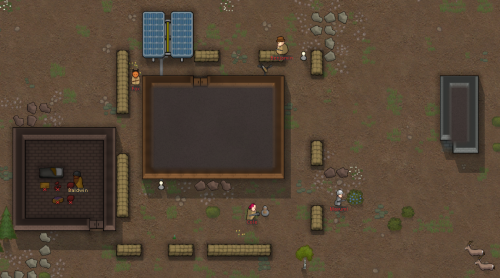
Whenever you reach a quest location, you wanna look for berries, healroot, animals and wood. Animals should be butchered before leaving, if the meat is too heavy and you still have time you can use the local wood to make lots of campfires and turn all into meals to reduce weight.
Winter is coming, it is gonna so cold that not any parka will do. Anything with worse insulation than cloth should be replaced by cloth. Cloth is average in insulation but really cheap to buy.
Fourth agenda
- Replace the cloth parkas for better insulating parkas.
- Use stone to reinforce your walls with a second layer for better insulation.
- Research electricity.
- Research battery.
Notes
Now it is cold, so cold that even cloth parkas are not enough.
Try to replace your cloth(cold insulation 18) for bearskin(cold insulation 20), bluefur(cold insulation 20), foxfur(cold insulation 20), devilstrand(cold insulation 20), alpaca wool(cold insulation 22), synthread(cold insulation 22), wolfskin(cold insulation 24), muffalo wool(cold insulation 24), megasloth wool(cold insulation 26), hyperweave(cold insulation 26),chinchilla fur(cold insulation 30), heavy fur(cold insulation 30), thrumbofur(cold insulation 34).
Likewise, now you should only send people out on quests if you got a strong insulating parka for them.
Raiders are now more numerous and if you keep doing quests you should have enough food to feed five people.
Fifth agenda
- Make your first greenhouse with a sun lamp and heaters.
- Plant potatoes.
- Research air conditioning.
Notes
Winter is gone and summer is coming, you should get ready to make a freezer so your food will not spoil.
Finally you are ready to make a greenhouse and plant potatoes. Ideally, try to connect your greenhouse to your steam geyser.
Since you got a reliable food source, you can now accept more people. You are not free of cannibalism yet, but you can stop offering help to refugees and stop going to quests just to get more food.

Sixth agenda
- Research hydroponics.
- Research nutrient paste dispenser.
Notes
With hydroponics basins you may make greenhouses without having to stick to stony patches. Getting anything planted here is expensive, so you should make a nutrient paste dispenser to save on food, once you got one you may stop doing cannibalism.
Since the worse is gone, you can now move to a proper area, a more central location where you can build that huge colony you always dreamed of.
Finding a large pound is much easier than finding a large stony patch. If happen to have a large pound in a central location or your map has coast you should focus on moisture pumps, with them you can create larger crops fields so you do not need to stick to stony patches around mountains.
Extreme desert guide (new)
This guide details how to survive in one of the most hostile environments in Rimworld - an extreme desert. We focus on the Lost Tribe start because it is the hardest one to thrive in hostile environments since you got more people to feed and less technology to help you.
Introduction
Extreme deserts are the most arid option of hot maps. They have the least amount of animal and plants. In fact, you should not expect to find anything more than three iguanas and a single cactus in your start. You should also not expect to see more than one new iguana per week and not a single plant ever growing in the wild.
In addition to that, they do not have any soil available, if you wanna grow something you will be doing it in stony patches around hills and mountains.
They are not necessary hot though, their average varies from 30 °C (86 °F) to 10 °C (50 °F) and growing periods varies from all year to half year days due to the temperature. You should expect to only have problems with heatstroke during summer and during heat waves.
Landing site
In all maps you should to choose carefully your landing site to increases your chances of survival. You want to build a colony in an area with some of the following characteristics:
- Near to a friendly faction base (faster trading)
- Near to a road (faster moving around)
- Without many mountains around (faster moving around)
- With a river (enable watermills)
- With coast (to turn into large growing areas later)
- With caves (early food source)
While you should not be surrounded by mountains, the landing site itself can be mountainous.
Of course you do not need to land in an area in all those characteristics, but try to get as many of them as you can.
Base area
Once you choose your landing site you should also choose your base area. It is important to notice that this area does not need to be final, it is just the area where you are more likely to survive the early game.
You want to find an area with the characteristics: more growing areas and more easily defendable.
More growing areas means more stony patches and more easily defendable area is an area with few entrances where you gonna lay down your traps.
Since you do not have trees, you can not build a big base yet. You can then either take a ruin, make a cave or make a small steel base. Ruins might look like good starting locations but are often on undesirable areas. It is easier to make a cave in a good location, since choke points are always surrounded by hills and mountains. But if you happen to get a ruin in the right place, then go for it. If you can not find a hill or a ruin in a good area then just make a small steel base.
First agenda
- Get some easily accessible steel and use it to build your stuff, so you do not have to use wood.
- Make your starter base. Give people a place to sleep, eat and play.
- Hunt those iguanas before they leave the map.
- Kill your starting animals.
- Only use wood to make campfires and passive coolers, for cooking and cooling down respectively. Make sure your wood is forbidden so they do not refuel them unnecessarily.
- Plant rice. You can not survive long enough to wait grow anything else yet.
- Plant strawberries, if you do not have much growing area then plant potatoes.
- Make your research bench and start researching stone cutting so you can start using stone instead of steel.
Notes
Surviving until your first rice harvest is the hardest part. Your pemmican plus your hunting plus your starting animals is not enough. If you have caves in your map, you can go insect hunting and that might be enough, but if you do not... You gotta go visit your nearby friendly base to trade whatever you can for food. For that, you gotta get something you can trade:
- You can mine expensive things like components, plasteel, uranium, jade, silver or gold.
- You can open the ancient shrine and sell whatever you find there.
One smart way to reduce your food consumption is to put some colonists inside the ancient cryptosleep caskets until your first harvest.
You can also go to the closest base outside the extreme desert and attack them. Hunt the animals and harvest the plants around the base and run back to your base. You can make peace with them later.
Another more undesirable option is to sell some colonists. They are usually worth a lot and it results on a lower food consumption which makes things much easier, but do not expect to see them again.
Likewise, another even worse option is to kill some colonists, but they are not worth many meals.
If you do survive though... Now life will be much easier.

Second agenda
- Plant cotton. Later you will use it to make dusters and cowboy hats.
- Plant healroot.
- Make stone deadfall traps.
- Plant cactus. Your future wood source.
- Plant smokeleaf. This will help your guys relax later.
- Research complex furniture. Once you done, make steel or stone beds.
- Research complex clothing. Once you done, make dusters and cowboy hats with your cloth.
Notes
Hopefully, now you grow strawberries, so you will not need to worry about wood. If you decided to stick with potatoes, you gonna have to make some extra visits to your nearby friendly base and buy wood for cooking because your cactus plantation gonna take a while to kick in.
Summer is coming, focus on getting cloth to give your colonists dusters and cowboy hats. After that you can replace their tribalwears for button-down shirts and pants.
You can also make some smokeleaf joints to help with the moods.
Always keep a stock of wood with you because if a heat wave happens you will need those passive coolers.
If you want, now you can accept more people in your colony.
Now the usual threats start, time to make some deadfall traps to defend your base. Since you do not have wood and probably not enough steel, you will have to go for stone deadfall traps.
Third agenda
- Research eletricity.
- Research battery.
- Research air conditioning.
Notes
Your colony is looking better, you have food, wood, clothing, drugs and defenses. You should focus on making a freezer for all that food you got.
Since the worse is gone, you can now move to a proper area, a more central location where you can build that huge colony you always dreamed of.
If your map has coast you should focus on moisture pumps, with them you can create larger crops fields so you do not need to stick to stony patches around mountains. They also remove the patches of soft sand preventing you from building.
Colony building guide (pre-'restoration')
This guide is the ultimate go-to guide to building your base, for all stages of the game.
Base Types
There are different ways to build your base. In all different designs one can opt to either predefine each room role or make modular rooms which are easier to expand but also less efficient.
Superstructure base
A superstructure base is a base where everything or almost everything is in one large building rather than smaller separate parts.
This is the most common method to build bases.
Pros
- Saves building materials and space.
- Easier to control temperature.
- Easier to defend against raids.
- More resistant against toxic fallout.
Cons
- Geothermal vents and patches of deep water can limit the design and patches of soft sand will require moisture pumps before building, marshy terrain can just be covered with bridges.
- Some areas might need to be unroofed to prevent cabin fever.
- Some large hallways might be needed to help defend against raiders dropping on top.
Separate structures base
Build everything in separated buildings, just like building a small town.
It is easier for starting off, but it is overall more vulnerable, so usually does not scale as well into late game.
Pros
- Easier to avoid areas with building restrictions.
- Naturally gets rid of cabin fever.
- Naturally offer areas in between buildings to fight raiders that drop on top.
Cons
- Requires more space and building materials overall.
- Harder to control temperature.
- Harder to defend against most raids.
- Vulnerable to toxic fallout.
Mountain base
For mountainous maps where you have less space to build, you can opt to dig inside the mountains instead.
Also very easy to start off, used to be the most popular kind of base but now depending on how bad the Infestations are it can be good or impossible late game.
Pros
- Saves a lot of building materials.
- Easier to control temperature.
- Easier to defend against raids.
- More resistant against toxic fallout.
- Free, beautiful floor and walls.
- Immune to sieges and raiders dropping on top.
Cons
- Infestations inside can be impossible to deal with.
- Cabin fever can be a real problem.
Base Structures
Different structures suit the different needs of your colony. Most maps generate with ruins around, sometimes just walls and others are squares/rectangles just missing some filling sections. These if conveniently located can work perfectly at starting points reducing considerably the initial workload of characters with low level skills and reducing the beginning stage stress when you still have nothing.
Warehouse
The warehouse is a room with a stockpile. The first room we need to build due to the "outdoors" deterioration on items if left in the open. It is not an official room role.
Later in the game the warehouse is usually the biggest room in the base. It should be covered by orbital trade beacons so you can sell your stuff to trade ships.
The electric crematorium and electric smelter may be placed here, if you store corpses, tainted clothes, useless guns and steel slag chunks inside, to speed up burning/melting them. Also, if you making chemfuel with wood you may place the biofuel refinery here.
It does not need to be impressive or temperature controlled and should be built close to the workshop to minimize travel times.
Bedrooms
Bedrooms are rooms with only one bed.
Only couples like to share a room, and all sleeping colonists will get disturbed by non-lovers walking about in the same room while they sleep, so once you have the resources you should upgrade to individual bedrooms for each colonist or couple. It is recommended to have double beds in all rooms since they have better impressiveness, and couples can use them should they strike up love.
Good bedrooms give good mood modifiers so they should have plenty of art, good flooring and high-quality furniture. It should be temperature controlled for better moods. Dressers and end tables are recommended in bedrooms to increase the comfort of the bed. Royal beds are particularly good to have in bedrooms if you can afford it.
Colonists like to eat as soon as they wake up, but do not place table and chairs inside the bedrooms or colonists will use other colonists' tables at night and cause 'Disturbed sleep' penalties, instead bedrooms should be built close to dining rooms. Still, some people choose to build tables and chairs inside for aesthetic reasons.
Barracks
The barracks is a room with multiple beds.
They are usually a good option early-game when resources are limited, or during late-game to deal with an overflow of people. Overall, it is better to have separate bedrooms since barracks give a lower mood modifier and cause a lot of 'Disturbed sleep' penalties.
Good barracks give good mood modifiers so they should have plenty of art, good flooring and high-quality furniture. It should be temperature controlled for better moods. Dressers are a very good addition to barracks since they increase the comfort of many beds at once.
Colonists like to eat as soon as they wake up, but do not place table and chairs inside the barracks or colonists will use the tables at night and cause 'Disturbed sleep' penalties, instead barracks should be built close to dining rooms.
Dining room
Dining rooms are rooms with table and chairs for colonists to eat in.
It is usually a good idea to have the main dining room near the food storage so your colonists will actually use the dining room, instead of eating on the floor. It is also a good idea to have smaller dining rooms near colonists' bedrooms or they might eat their breakfast on the floor since colonists tend to go to bed with food and eat as soon as they wake up.
In big bases, dining rooms can be partially unroofed to get rid of cabin fever since colonists do not mind eating in hot or cold rooms.
Good dining rooms give good mood modifiers so they should have plenty of art, light, good flooring and high-quality furniture. It does not need to be temperature controlled. Nutrient paste dispensers are very useful in dining rooms to ensure that nobody needs to eat raw food, they are usually placed half in the dining room and half in the freezer.
Dining rooms can be combined with recreation rooms.
Recreation room
The recreation room is a room with sources of joy.
Colonists get bored of using the same joy source repeatedly, so you should have as many joy sources as possible in the recreation room.
In the early game, all you need is a horseshoes pin and a chess table. During mid-game you can add a poker table, a billiards table and a tube television, then upgrade it to a flatscreen television. Later, buy a megascreen television and a telescope from traders.
In big bases, recreation rooms can be partially unroofed to get rid of cabin fever since colonists do not mind playing in hot or cold rooms.
Good recreations rooms give good mood modifiers so they should have plenty of art, light, good flooring and high-quality furniture. It does not need to be temperature controlled.
Recreation rooms can be combined with dining rooms.
Courtyard
You may consider building an unroofed courtyard in the center of your base where colonists can get some fresh air. It is not an official room role.
You can use it as a common area, putting joy items and dining tables for colonists to use, making the courtyard behave exactly the same as an unroofed dining/recreation room. It may also be used as a place to put your mortars as putting them in the middle helps negate their blind spots, or transport pods. This is better if it is a separate unroofed area as they are not beautiful to look at.
Freezer

The freezer is room with a stockpile that is kept cold by coolers. It is not a official room role.
The freezer is where you to keep your perishables that would otherwise spoil in the storage like food and corpses. Because you will be storing your harvests here, it is wise to position this room close to your plantations to reduce hauling jobs, with the doors pointing toward your growing zones. It should be covered by orbital trade beacons so you can sell your food to trade ships.
This is usually the second biggest room in the base. Nutrient paste dispensers are usually placed half in the dining room and half in the freezer.
Even though food freezes at 0 °C (32 °F) you should have your freezer at least set at -5 °C (23 °F) since it will lose temperature whenever a colonist comes in. It is common to make airlocks in the entrance of the freezer to reduce that temperature exchange. It is also common to make the freezer with double walls to increase insulation. The freezer is vulnerable to solar flares.
To save power it is a good idea to have the coolers set to different temperatures. For example, if two coolers are set to -5 °C (23 °F) then both will always consume power, but if a cooler is set to -5 °C (23 °F) and another is set to -8 °C (17.6 °F) then the first will only consume power during hotter times when the second is not able to keep the temperature bellow -5 °C (23 °F) alone.
Coolers placement is of crucial importance as these devices have a very low HP, making them the weakest point in a wall from where raiders would break in easily and most likely ignite your food supply. Because of this, one of the best ways to keep your freezer away from harm is to place the coolers in the inside unroofed, or of course, wall off the coolers too.
Butcher spots, butcher tables and crafting spots can be placed inside the freezer to butcher corpses, make kibble and make smokeleaf joints, since the work to make those is so small and the ingredients are in the freezer your colonists might as well do it there. However, for mass production, it is better to have it close but outside the freezer due to the work speed penalty.
It does not need to be impressive and should be built close to dining rooms and kitchens.
Kitchen
The kitchen is a room with a stove or a butcher table.
The kitchen is where your colonists turn raw food into meals. The room should be clean to avoid food poisoning, so the butcher table may be placed nearby in a different room instead since it creates a lot of filth.
Besides stoves, the kitchen should include chairs, light and sterile tiles. You might want to add a little vegetable stockpile inside to save travel time, as plants take a while to spoil. Not flooring the kitchen can be a better option if you lack sufficient janitors, as dirt floors have less of an impact on both cleanliness and beauty than the dirt tracked into the kitchen, unless if you kitchen is full of blood instead of dirt.
Since the kitchen is placed near the freezer, some crafting stations which include plants ingredients may be also placed in here. The brewery and drug lab are good choices and if you do place them here you should also add tool cabinets and little stockpiles for hops, smokeleaf leaves, psychoid leaves and neutroamine. Also, if you making chemfuel with food you may place the biofuel refinery here.
It does not need to be impressive, but it is usually a good idea to add a little art since colonists tend to stay there for a long time. It should be temperature controlled for better working speed.
Zone out colony animals.
Workshop
The workshop is a room with crafting stations.
The workshop is where your colonists turn raw materials into advanced products. Besides crafting stations, the workshop should include chairs, light and tool cabinets. A lot of different little materials stockpiles may be placed inside to save travel time.
Early game crafting stations include the stonecutter's table, sculptor's table, hand-tailoring bench and fueled smithy. Mid game crafting stations include the machining table, as well as the electric versions of hand-tailoring bench and fueled smithy. Late game crafting stations include the fabrication bench.
The brewery, drug lab, biofuel refinery, electric crematorium and electric smelter may also be placed here.
It does not need to be impressive, but it is usually a good idea to add a little art since colonists tend to stay there for a long time. It should be temperature controlled for better working speed.
It should be built close to storage.
Laboratory
The laboratory is a room with a simple research bench or a hi-tech research bench.
Research speed is affected by the cleanliness of the room which is why it might be worth making a separate room for it. It should be isolated to avoid other people walking in dirt.
Besides the research bench, the laboratory should include a chair, light and sterile tiles. After you get the hi-tech research bench you can also get a multi-analyzer.
It does not need to be impressive, but it is usually a good idea to add a little art since colonists tend to stay there for a long time. It should be temperature controlled for better working speed.
Zone out colony animals.
Hospital
The hospital is a room with a medical bed. It is a place specialized in treating your colonists. If you do not have one, colonists will be treated in bedrooms. The room should be clean to avoid infection.
In early-game all you need is floors, beds and a light source. During midgame you should replace your floor with sterile tiles and your beds with hospital beds, and add vitals monitors. All these will increase treatment quality.
Store medicine in or near your hospital so your doctors can quickly patch up your colonists.
Good hospitals give good mood modifiers so they should have plenty of art and high-quality furniture. It should be temperature controlled for better moods and to prevent heatstroke or hypothermia from visitors. Since injured colonists will likely spend a lot of time in the hospital it is a good idea to add televisions which they can watch while in bed. If you do not have televisions, other colonists will go to the hospital to cheer them up to provide joy.
It should be built close to the base entrance for quicker rescue.
Zone out colony animals.
Armory
The armory is a room with a stockpile for weapons and armor. It is not an official room role.
Often your colonists need to change their guns and gear to better fight different kinds of raids. Having an armory helps to keep your gun and gear stock under control and puts them in a more accessible position for your colonists to grab them quickly.
It does not need to be impressive, nor does not need to be temperature controlled.
It should be built close to your defenses for quicker reaction to raids, and should also be far away from the prison.
Barn
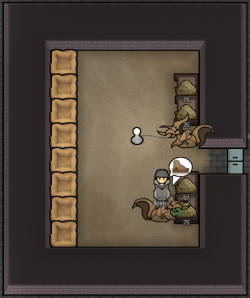
The barn is a walled area with animal sleeping spots, animal sleeping boxs or animal beds.
Barns help ensure that hauling animals will go back to your base at night for safety and that fragile animals will be isolated from predators. They are also used to ensure that animals products will drop near your base for quicker hauling.
They should include stockpiles of hay or kibble for the animals, if they are placed outside they should be in a shelf to avoid deteriorating. Since animals go back to their boxes or bed for healing it might be a good idea to store medicine near your barn for quicker patching up, again if placed outside they should be in a shelf.
Sometimes, it is good to have a small separated barn to bring in wild animals that you want to tame. Wild animals might go away or die for many different reasons, but if you keep them in an isolated room with food they will stay there forever. A good example is an animal herd passing through the area. You will not have time to tame them, but you can beat them down and bring them to your base and have all the time you need to tame them. Also prevents them from causing damage if the taming fails.
It does not need to be impressive, indeed it is better to not put down floors to avoid animal filth. It does not need to be indoors but you might want to at least partially roof it in case a toxic fallout happens. It does not need to be temperature controlled unless if your animals cannot handle the local temperature.
It can be combined with outdoors rooms, like your power supply area. It should be built close to freezer or warehouse.
Prison
The prisons is the place where you put your captives of war. Better prisons make it easier to recruit people. Still, they are not consistently used, so one should consider how much effort and resources should be invested in it. During mid-late game, prisoners without immediate use can be kept for free inside cryptosleep caskets instead.
Basic features:
- Enclosed by walls.
- Beds or sleeping spots.
- Safe temperature.
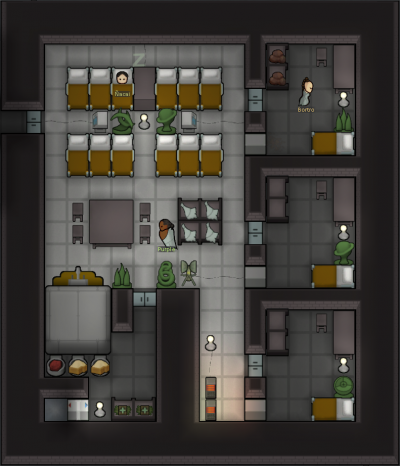
Good mood features:
- Light source.
- Floors.
- Table and chairs.
- Art.
- Comfortable temperature.
- Dressers and end tables.
- Psychic emanator.
Convenience features:
- Food stock.
- Medicine stock.
- Uniform stock.
- Nutrient paste dispenser.
Medical features:
Safety features:
- Isolated from the rest of the base, but not close to the map edges.
- Isolated from any potential weapons, even wood and beer.
- Doors connected to an empty walled area, possibly guarded by turrets.
Prisons can have the following rooms:
Prison barracks
Barracks are rooms with multiple prisoner beds.
They are cheaper than cells and allow for features that are unreasonable to have in every single cell. The barracks mood modifier is lower than the cell but the barracks usually provides the 'Spacious interior' modifier and better dining room modifier, so they arguably offer better mood than cells since prisoners do not get 'Disturbed sleep' penalties. However, if a prison break happens all prisoners in the same barracks will break out together.
Prison cells
Cells are rooms with a single prisoner bed.
Cells offer only slightly better mood improvement than barracks and usually are much more limited in what they can have. The major advantage of cells is that if a prison break happens, not all prisoners in nearby cells will join. They also prevent fights between prisoners.
If you are lacking space for prisoners, a colonist bedroom can be temporarily turned into a cell.
Prison hospital
The prison hospital is a room with medical prisoner beds. It is not an official room role.
Prisoners often first enter your prison injured, so having a proper prison hospital can help avoid unnecessary deaths and infections. They are like a regular hospital attached to the rest of your prison, however, you do not need to have televisions in it since prisoners are not affected by joy.
The prison hospital does not need to be a separated room only for healing. It can be the barracks but with medical features.
Prison freezer
The prison freezer is a room with a stockpile kept cold by coolers inside the prison. It is not an official room role.
For storing stocks of food and herbal medicine to prevent spoilage. If you have a Nutrient paste dispenser you can place half of it and all the hoppers inside.
Tomb
The tomb is a room with sarcophagi.
Not the most important of the rooms, but colonists do go visit sarcophagi or graves filled with dead colonists for joy so you might want to give a nicer room for them to do that.
It does not need to be impressive or temperature controlled and can be built anywhere.
Production
You will need fields, buildings and animals to provide the raw materials that your colony needs.
Crop fields
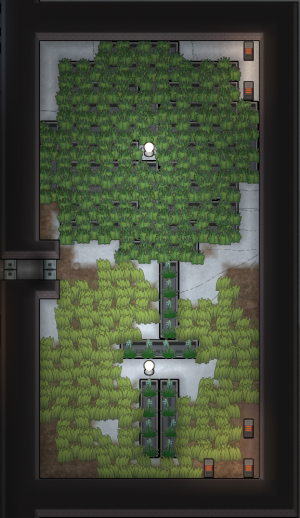
See also: Food production
Crop fields are growing zones or hydroponics basins, designated to the desired plant type.
Depending on the soil fertility different plants might generate the best productivity:
Crop fields do need to be protected from raiders or they will burn them down, which can be hard on harsh biomes where the fertile soil might be far away from your base; however, crop fields are not particularly important structures, so they need not be given priority in defense.
They also need to be protected from animals, both wild and domestic. Crop fields are vulnerable to blights and toxic fallout.
Ideally, they should be made near your freezer.
Greenhouses
Greenhouses are a protected version of crop fields. They are growing zones or hydroponics basins in a temperature controlled environment. Since they are indoors, they also require sun lamps.
They are much more expensive than fields but they allow crops to grow all year in cold environments. It is common to make airlocks in the entrance of the greenhouse to reduce temperature exchange and make it with double walls to increase insulation. They are vulnerable to blights and solar flares.
To save power it is a good idea to have the heaters set to different temperatures. For example, if two heaters are set to 21 °C (69.8 °F) then both will always consume power, but if a heater is set to 21 °C (69.8 °F) and another is set to 24 °C (75.2 °F) then the first will only consume power during colder times when the second is not able to keep the temperature above 21 °C (69.8 °F) alone.
Ideally, they should be made near your freezer.
Mines
Mines are areas your colonists go to mine.
If you are mining the stones in the outside layer of a mountain then you got nothing to worry about. However, if you decide to mine deep inside a mountain, then you need to build a proper mine as you mine out the stones to avoid rocks collapsing on top of your colonists. Wood is usually a good cheap material to use to make mines.
Another thing to worry about when making mines is infestations. You can build doors inside your mine to create choke points where you can fight the insects and help your colonists running away. Alternatively, you can fill up the whole mountain with wood so infestations can not happen at all.
Drilling rooms
Deep drills are often placed far away from your base and similar to mines that they can also cause infestations. So you might want to enclose the area with walls and doors to create choke points where you can fight the insects and prevent predators from attacking isolated miners.
Animals
Animals have a variety of uses, therefore herding some of them in your barn can be very helpful. Of course all animals can be used for different reasons, but it is worth mentioning some of them because they are either particularly useful or versatile:
- Produce raw food: eggs, milk or meat. Chicken, Cow, Dromedary, Muffalo, Pig.
- Produce textiles: leather or wool. Chinchilla, Alpaca, Dromedary, Muffalo, Megasloth.
- Produce fuel: chemfuel. Boomalope.
- Haul animals. Pig, Wild boar, Elephant, Megasloth.
- Pack animals. Alpaca, Dromedary, Muffalo, Elephant.
- Combat animals. Wild boar, Elephant, Megasloth.
Chicken, Cow, Chinchilla, Alpaca and Boomalope are quite profitable.
Pig, Wild boar, Elephant and Megasloth are the only ones that can graze and haul.
Dromedary, Muffalo, Elephant and Megasloth are really versatile.
One should notice that combat animals are much better at defending caravans than defending your base.
Power
Your colony needs power, so you should provide generators and protect them from attacks. Therefore, it is better to place them inside your base walls. Your options for power generation include the following.
Solar power
Solar generators provide power only during the day. It provides 1700W during summer peak hours near the equator, but little to none during winter near the poles. They are particularly good to power up sun lamps since these only consume power during the day. They should be used together with batteries so you may still have power during the night. They are vulnerable to eclipses.
Wind power
Wind turbines provide unstable power throughout the day. It can provide up to 3000W, but it usually gives less than that. They should be used together with batteries to make up for the instability.
It requires plenty of open space for maximum efficiency and any obstacles can easily reduce efficiency. To prevent trees from growing and obstructing the turbines, you may grow crops underneath the turbines or fill in the gaps with solar generators.
Fueled generation
You can get the wood-fired generator which runs on wood, or the chemfuel powered generator which runs on chemfuel. Both provide a constant 1000W of power, so it is a good idea to have some of these as a backup power source, or even as your main source in biomes that are loaded with trees. Since they are stable they do not require batteries.
Chemfuel is significantly more efficient than wood, so once you research the biofuel refinery it is better to refine wood into chemfuel before using it as fuel.
They are useful complementing solar generators during winter in cold biomes, since solar generators does not work in winter near the pole.
Boomalope setup
3 Boomalopes generate enough chemfuel to run 4 generators. It is easy to run an entire base on that setup since they generate more energy than you spend to grow food for them, specially if your colony is somewhere they can graze.
Infinite chemreactor setup
Infinite chemreactors generate enough chemfuel to run a generator, which in turn generates more than enough power to run the chemreactor.
It is overall an amazing setup but infinite chemreactors are hard to come by, so you should not expect to run your whole base on that.
Geothermal power
Geothermal generators constantly gives 3600W of power after being built on a steam geyser.
While powerful, it has one big issue; you can not choose where the steam geysers will be, so if you do not have one inside your base you need to cover them with walls to protect them. If you wall off your geothermal generator completely with double walls the raiders will ignore it most of the time. They will, however, sometimes randomly attack your walls, but it is really unlikely that they will destroy both walls and reach the generator. As it can randomly break down, you should still add doors so colonists can enter, better to use stone doors because they are durable and raiders can not ignite it.
Another problem is that raiders will likely destroy the conduits connecting the generator to your base, so build multiple conduit lines to reduce the likelihood of raiders completely severing the connection. Also, even though they do not need batteries, you should build some in case it gets disconnected during a raid.
Note that they generate plenty of heat, so they should be unroofed or they will catch on fire.
Watermill generator
The watermill generator constantly provides 1100W of power but has to be placed next to rivers. So you must include the river inside your base design. However, that is usually quite simple since rivers tend to cross the whole map edge to edge. It does mean you will have to wall off a larger area, but it is well worth it since the watermill is quite reliable and lots of them can be placed on the same river.
It is quite easy to run a base just on watermills but of course, rivers are not available in every map. Since they are stable they do not require batteries.
Vanometric power cell
A vanometric power cell constantly provides 1000W of power and can be placed anywhere. Like the infinite chemreactor, they are hard to come by, so you should not expect to run your whole base on that.
They are particularly good for starting off new bases, or sometimes powering isolated objects such as deep drills.
Power storage
Batteries store surplus power. They are recommended for when you rely on power sources that are not constant, such as wind or solar power. They allow for power storage during times of excess to be used during times of demand. For instance, this makes them useful to store spare power generated during the night from fueled generators in order to supply sun lamps during the day.
Not having batteries is also beneficial, if you have reliable power sources, since it almost nullifies the short circuit event, igniting a little fire instead of causing a huge explosion.
Batteries need to be placed under a roof to prevent short-circuits during rain and should be placed indoors to protect them from external threats. Connect them to the grid via switches and shut off part of them after they are filled to reduce the impact of short circuits and have back up batteries in case of emergency.
Power network
It is not a good idea to have just one conduit spanning the entirety of your base. While it saves materials, short circuits or other events can create breaks that can disconnect entire parts of your base from power. Instead, build a network with redundant pathways so that the grid will continue to function even if there is a break.
Also, it is better to split the power network of your base. Having more than one power network makes power management harder but the short circuit event will be much smaller since it will not affect your whole base and all your power reserves.
Defenses
Unless you are playing on peaceful difficulty, you will eventually encounter major threats, so you will need to prepare your defenses for that.
More defensive buildings can be seen on defense structures. Here, we show only the basics.
Static cover
At the very least you must have some sources of cover in your base. This includes sandbags and sometimes walls. They are enough on early-mid game or on easier difficulties.
In a static cover based defense, it is better to combine two different types of cover structure, one using walls and another with sandbags covering the sides. The walled cover should be used where the enemy will engage, as the walls restrict the attack angle, and there should not be anyone standing behind the sandbags- these should be for soaking fire from oblique angles only. The other kind should be used at the sides to allow for a more flexible attack area.
The major problem of basic static cover is enemies with long-ranged weapons. They will have a lot of time to shoot at you while you are busy with the rest of the raid party. Raiders with triple rocket launcher and doomsday rocket launcher are particually dangerous if you rely on static cover since they are really long-ranged and only need one shoot to explode your defenses. For those reasons you might want to enclose your combat area into a killbox.
Killbox
A basic yet powerful defense setup is the killbox. It is a walled area full of traps and turrets where you fight your enemy, making sure they do not out-range you or have cover, while your colonists have plenty of cover. It only works if it is the only entrance to your base and your whole base is surrounded by double walls.
Turrets should all be connected to your power grid by power switches. Put them in front to distract enemies such that they go for them before your colonists. They should be switched off if a manhunter pack shows up, as it is better to let them die by your traps and finish them off by melee blocking them.
If a full-melee raid with shield belts or a scyther-only raid shows up, throw EMP grenades at them while they gather around your turrets as it will disable them. While they are occupied attacking the turrets, you can shoot them up, and if they manage to destroy all the turrets, prepare to finish the survivors by melee blocking them.
Centipedes with inferno cannons are one of the major counters of killboxes, since the fire makes your colonists lose control and run out of cover. They are the main reason why you should have walls and not only sandbags in your defense. Their inferno cannons can shoot over sandbags but not over walls, so a colonist behind a wall is less likely to catch on fire than a colonist behind a sandbag. Having some firefoam poppers inside your box helps a lot with extinguishing fires and preventing future fires. EMP grenades also cripple them a lot if you can get close enough to throw them.
Raiders with triple rocket launcher and doomsday rocket launcher are still a problem. If they manage to shoot inside your box the damage can be massive, but here they are in range of your colonists' guns so you can focus them down before they do anything.
Some enemies do not run into your box, but can be lured into it, such as raiders from sieges or mechanoids guarding crashed ships. Snipers can safely poke them from far until they aggro and bring them to the box.
Killboxes do not protect against sappers and raiders dropping on top of you. For those, you will need another strategy.
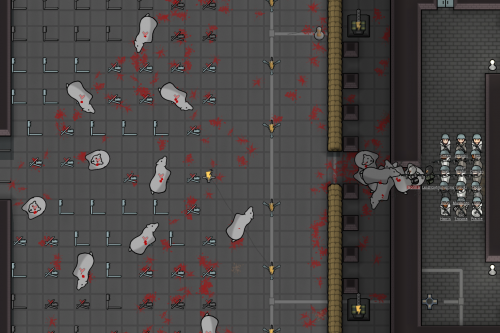
Temperature control
Some rooms should have its temperature regulated by some method or another, so as to keep a comfortable temperature for colonists to work and sleep in and protect them from extreme temperature conditions such as heat waves, cold snaps or simply the outdoor ambient temperature.
Larger rooms such as your kitchen and workshop should have their own heaters and coolers. If they are interconnected you may want to open doors for faster colonist access and temperature exchange.
Smaller rooms such as your bedrooms should be thermally connected to a larger central space through vents. Your heaters and coolers should be all placed outside the bedrooms. This reduces the number of heaters and coolers you need to build while keeping your bedrooms at a comfy temperature at the same time.
Keep in mind, that you will also need to be prepared in case of unusual temperature events, such as heat waves or cold snaps. Which, in severe cases, will cause heatstroke or hypothermia. Heat waves will also spoil your food and corpses.
Temporary temperature control
If your regular heaters or coolers are not enough or there is a temporary power outage or you are a tribe without the ability to harness electricity yet, you can use campfires or passive coolers to heat or cool down your base respectively. Both have the same effect as their electric variants, except that they need to be refueled and are limited in their available temperature range: campfires can not heat above 30°C while passive coolers can not cool below 15°C. Also, their temperature effect is full and cannot be controlled. Depending on what gear your colonists are wearing, it is possible for them in a room heated with campfires to complain about it being too hot.
These are best used to keep colonists comfortable during heat waves or cold snaps. If you always encounter uncomfortable temperatures during summer or winter then it is time to get more heaters or coolers.
Miscellaneous
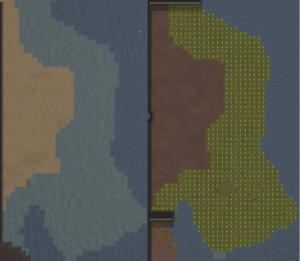
Do not rush flooring
Until you have enough manpower to spare for cleaning jobs, instead of building any floors, you can use the terrain as floors. Terrain does not generate animal and human filth and filth trailed on constructed floors makes for a much worse beauty penalty than using dirt floors, so this can actually make your rooms look better. It is also cleaner than constructed floors with dirt on them.
However, for places like hospitals, it is always better to use sterile tiles and manually clean them instead.
Flooring outside
To reduce the amount of dirt inside your colony buildings, put any kind of flooring covering places where colonists and animals frequently walk. This reduces the amount of dirt brought inside your base.
This should obviously be done only if you have enough janitors.
Moisture pumps
Moisture pumps clear out moisture from the ground around them, creating dry land suitable for construction and agriculture. They are excellent in swamp biomes for clearing out shallow water, marshy soil and mud in order to build structures. Their effect is permanent, so they can safely be deconstructed once the land you want to use is dry. Note that shallow water will be converted to stony soil, which only has 70% fertility. Still, this can be the only way to farm on the ground in biomes like Extreme Desert and Ice Sheet. Can not be used for farming in Sea Ice since it creates ice ground.
Ice sheeet guide (neo)
This guide details how to survive in one of the most hostile environments in Rimworld - an ice sheet. We focus on the Lost Tribe start because it is the hardest one to thrive in hostile environments since you got more people to feed and less technology to help you.
Introduction
Ice sheets are the coldest option of cold maps. They have very little animal life and no plants. In fact, you should not expect to find anything more than five snowhares in your start. You should also not expect to see more than one new snowhare every five days and one new polar bear per month.
In addition to that, they do not have any soil available, so anything that you want to grow must be grown on the stony soil patches- that is if you can even grow anything due to the cold. You will struggle a lot until you get a heater and a sun lamp, then you can plant something indoors.
Even the warmest ice sheet it really cold. Their average varies from -20 °C (-4 °F) to -40 °C (-40 °F) and they never have growing periods due to the temperature. You still need to eventually make a freezer though, because the summer temperature is hot enough to spoil your food. Expect to have problems with hypothermia during fall, winter, spring and during cold snaps in summers.
Before the start
You can opt to sweeten your survival experience with a combination of well-picked colonists and landing spot, or choose to go hard and randomise everything. The below assumes you are going for the former.
Landing site
In all maps you should choose your landing site carefully to increases your chances of survival. You want to build a colony in an area with some of the following characteristics:
- Near a tundra (faster moving around)
- Near a friendly faction base (faster trading)
- Near a road (faster moving around)
- Without many mountains around (faster moving)
- With coast (to turn into large growing areas later)
- With caves (early food source)
Ice sheets do not have roads or rivers, but that does not mean you can not settle close to a road. While you should not be surrounded by mountains, the landing site itself can be mountainous.
You do not need to land in an area in all those characteristics, but try to get as many of them as you can.
Starting colonists
Ice sheet is so harsh that you will have to resort to cannibalism, so you may want to have a crew that can tolerate that. That means having one butcher that does not mind butchering people and everyone resistant to mental breaks.
Your butcher should be either Cannibal, Bloodlust or Psychopath.
All your crew should ideally be either Cannibal, Sanguine, Optimist, Iron-Willed, Steadfast or Masochist with scars. Couples also enjoy extra happiness so try to bring couples instead of bachelors, likewise Beautiful and Pretty colonists are also good since they are more likely to fall in love with someone.
Surely you do not need to have all five starting colonists with those characteristics, but the more resistant colonists you have the better.
The first step
Once you choose your landing site and colonists you should immediately pause the game. This gives you time to make decisions.
Base area
You need to choose your base area wisely. It is important to notice that this area does not need to be final, it is just the area where you are more likely to survive the early game.
You want to find an area with the characteristics: near steam geysers, near steel, more growing areas and easily defendable.
More growing areas means more stony patches and an easily defendable area is an area with few entrances where you can lay down traps. Your priority is steam geysers. You have to make the base on top of a steam geyser, or else you will die of hypothermia very fast.
Since you do not have trees, you can not build a big base yet. You can either take a ruin, make a cave or make a small steel base. It all comes down to what you have near the steam geysers. If you have a ruin, take it. If you have a hill, make a cave. If you have none of these, make a small steel base.
Work
Analyze your team, set their priorities. Haul everything towards your chosen ruin and don't use wood at all except for the campfire.
Start mining steel as your main construction material or begin caving in. Play as minimalistic as possible. Gather enough steel to build walls by setting everyone to mine. Use terrain features to get the smallest home you can make besides any nearby structures.
If you have researchers, rush electricity research. You don't need to build a fortress yet, and electricity can be extremely helpful in survival.
Animals & Hunting
Set an animal zone away from your food, you don't want them eating your food as you can't win the game with pets alone. Let them all die of starvation, sorry. Starving pets are excellent lures for predators and while wild animals attack your pets, they won't turn their hunger rage towards you and you can attack them without danger, so long as their target is mid to big size (terriers die in a bear hit or two).
Hunt every time you see meat, as animals have the tendency to leave the map and won't remain roaming around for long. When you find one snowhare, you find the others. Double click on zoomed out view to reduce the time spent on searching.
Always keep an eye on the polar bear food bar- you will need to know when it will strike.
Steam geysers
Now that you've selected somewhere to settle, the next step is to build a decent base.
You should settle on the steam geyser due to the heat source. Living on top of a geyser provides warmth enough up to 10 degree Celsius, just to escape hypothermia. If your colonists complain about "sleeping in the cold", you tell them to man up. The only two reasons to build a campfire are to cook and an emergency extra source of heat when hard snow hits during Winter or a cold snap. Build a wall around it(10x10, the geothermal power plant is 6x6 so between the wall and the steam, the 8x8 line will become a one tile surrounding corridor just enough to place beds around), either by emulating a heater in the center of your room or by pulling a one tile corridor towards your home, even possibly digging a tunnel depending on the terrain altitude map of choice.
Eventually, you should ideally repeat the same geyser-room procedure with other steams in proximity, this is because cold and starvation will not kill you, but mental breaks will. For example, having more than two characters on berserk. Sometimes, two geysers may be close to each other, allowing you to use them at both ends while you build everything else in between. This lucky situation can allow to start building individual rooms for your people and get rid of the barrack penalties.
Cannibalism
It's inevitable. Just be very selective when butchering other humans as the character performing the action will receive mood penalties that can easily set it to mental breaks. It is okay if your characters complain of hunger. Again, keep your food supply on check and only feed your people when starvation kicks in, unless of course, their mental break is too dangerous to risk keeping them unhappy. When butchering human corpses it's best to set one same character to chomp many at once so that all the penalty goes to just that one guy, and performing the action on same day will keep the penalty length shorter instead of extending after each consecutive day. Best if the penalty wears off all at once.
Remember that human leather is worth a lot and it is better to make something with it first, then sell it. First, give your colonists bedrolls to sleep, then make dusters since they are more profitable than anything else. Cannibal and Bloodlust colonists will want to wear human leather clothes, give them human leather button-down shirts and pants, but not parkas as the material is just too bad at insulating.
The second step
Research
After electricity, go for Batteries, Solar panels and then Stonecutting so that you can start building plantation-rooms. Sun lamps consume large amounts of electricity and you should by then have enough power and stored energy so that your crops grown steady. Solar generators will not perform to their maximum capacity due to the short solar cycles common in polar regions as oppose to equatorial regions.
If you are not in a hurry, you can include complex furniture research, so you can make beds, as well as stonecutting so you can use the more abundant stone.
Opening ancient shrines
You can open the ancient shrine. They contain people which can be either killed for food or recruited into your ranks, as well as some items that can be sold.
Ancient shrines are dangerous; make sure you are suitably armed.
After you clear the shrine, you can build furniture in it to live in; you can also send your people to cryptosleep to extend your food stocks.
Bartering
You will need to barter for some resources that are hard to get.
Aim for wood and cloth. To gather money to buy them, you can mine expensive things like components, plasteel, uranium, jade, silver or gold.
Greenhouse
After you have researched Electricity, Batteries, Solar Panels and Stonecutting AND crafted lots of stone blocks is when you can start building your first plantation room. Since the biome has scarce fertile tiles, you can easily select to mark a Grow zone and just drag your cursor on a 50x50 tiles area so that the game automatically marks where there is a "large" concentration of farmable area. Then just select the Sun lamp so that you can have the radius on your cursor ready to match such area. If you happen to lack said farmable tiles anywhere close to your base, you can fill in the blanks with hydroponic basins later on.
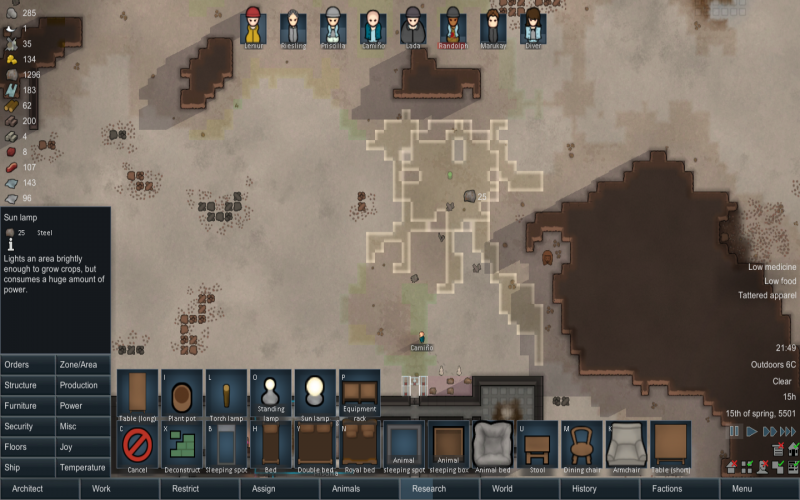
Then use "Delete zones" to remove all growing zones that were created during the scan for farmable tiles, and use the "order" to "plan" to draw a cross of 11 tiles with tile number six (the crossing), being the location where the Sun lamp will be located. This will give you the radius of the lamp so that you can start setting the structure plans. Do use double walls for better insulation and with an airlock system as well.
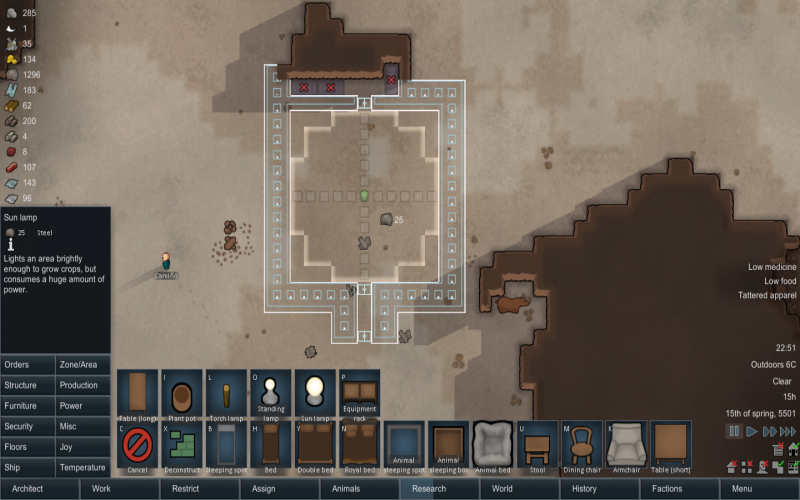
Once everything within the plantation room has been built, click the sun lamp and press "H" for the sun lamp itself to create a growing zone for you (instead of the conventional manual way). Start with rice, and harvest enough so that you can bring everybody else who has been in cryptosleep all this time for your colony to start running in full strength. Remind yourself that once temperature starts to drop again in Winter, you will need to install several heaters or plants will die.
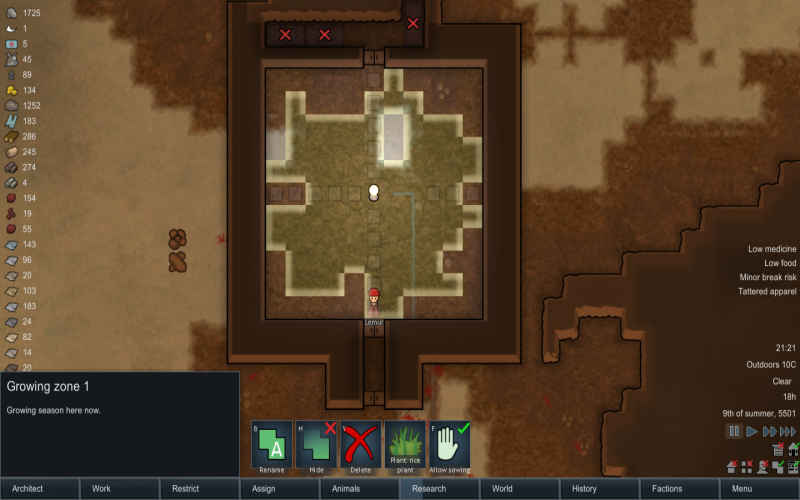
In the meantime, there's no need to rush directly your research towards hydroponics. You can go through Complex clothing, Drug production, Penoxycyline and then Hydroponics. Of course each player will play different stories, so adjust to circumstances as needed.
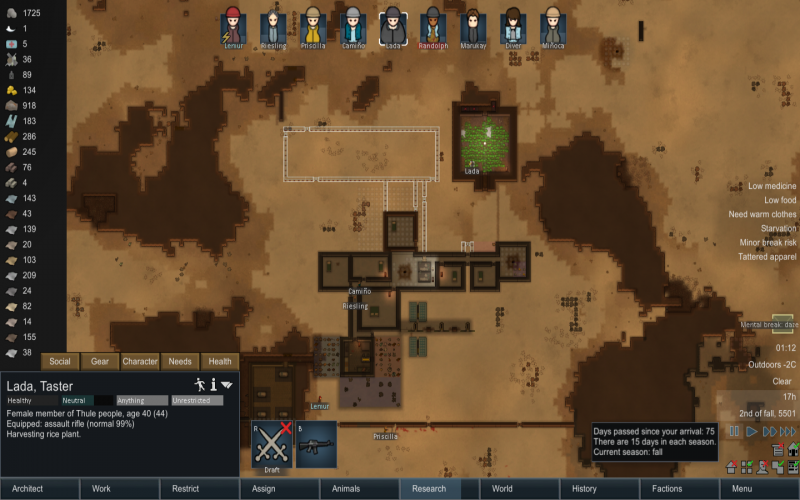
In this demonstration, the first harvest takes place 75 days after start. Now you have both shelter and food. From here on, it's all up to you. Good luck!
The third step
Expanding to the world
You can start to do world quests for factions, once you stabilised your food supplies.
- Go get item stashes.
- Go help incapacitated refugees.
- Go rescue prisoners.
- Go destroy enemy outposts.
You can also choose to raid enemy faction outposts. They can contain food stocks that you can loot.
Whenever you reach a quest location, you wanna look for berries, healroot, animals and wood. Animals and marginally other humans should be butchered before leaving, if the meat is too heavy and you still have time you can use the local wood to make lots of campfires and turn all into meals to reduce weight.
Slighly more advanced technology
Once you research nutrient paste, you can make food efficiently for your people. This also frees a cook to do other things.
If you have enough power, hydroponics basins can also be helpful in feeding your people. This allows you to build greenhouses freely instead of being restricted to growing food in the stony soil patches.
Emergency measures
If the game is bearing down on you, you can use these measures to prolong your colonists' lives. These can ruin the true experience of an ice sheet survival though, so make these a last-ditch measure.
Cryptosleep
If you come across an ancient shrine, you can put your colonists to sleep inside. This helps to extend your food stocks when you fall on hard times.
Caravaning
Another alternative is to escape while you still can- the ice sheet just isn't for you. Gather whatever food you can, along with some supplies, then break for it.
Sea Ice Gudie
This guide details how to survive in the most hostile environment in RimWorld - sea ice. We focus on the Lost Tribe start because it is the hardest to thrive in hostile environments since you have more people to feed and less technology to help you.
The tribal start in sea ice is the ultimate survival challenge in RimWorld and very close to being impossible, therefore there is not much room for different strategies here, you have to stick closely to the guide.
This guide was made on version 1.0.2096 on Cassandra Merciless.
Introduction
Sea ice is one of the coldest option of maps. There is almost no animal life and no plants. In fact, you should not expect to find anything more than three snowhares in your start. You should also not expect to see more than one new snowhare every week.
In addition to that, they do not have any kind of soil available and moisture pumps will only generate more ice. It is literally impossible to grow anything on the ground. You will struggle a lot until you get a heater, a sun lamp and a hydroponics basin, then you can plant something indoors.
The worse part is that they do not have ruins, geothermal vents or minerals to mine. Also, deep drills do not work. There is literally nothing here to even build a base with. You will have to rely on trading, quests and random events to get any material to build a base.
Even on the warmest sea ice tiles, it is still really cold. The average varies from -20 °C (-4 °F) to -30 °C (-22 °F) and they never have growing periods due to the temperature. You still need to eventually make a freezer though, because the summer temperature can be hot enough to spoil your food. Expect to have problems with hypothermia during fall, winter, spring and during cold snaps in summers.
They are particularly bad to travel in caravans. They do not have roads and are always placed in the poles of the world, so they have a big penalty to caravan speed due to winter, which is most if not the whole year. But caravans are more important here than any other biome, so you will have to do it anyways whenever you can, because you do not have other options to get the resources your colony needs.
Landing site
In all maps you should choose your landing site carefully to increases the resources available. Landing in the wrong spot not only makes your start harder, but also makes your mid-late game frustrating, as it severely limits you from using the whole caravan and quest system. Sea ice is always in bad locations, but there is one thing that makes some areas better:
- Near a friendly faction base (faster trading)
Sea ices do not have roads or rivers, neither does ice sheet which is always next to you. All you can do is be near to a friendly faction base. Without trading it is already impossible to survive.
To make things better you should settle close to two faction bases. You will expand much faster in the mid-late game with help of two faction bases instead of just one.
Starting colonists
There are a few things to consider while selecting your colonists for sea ice:
- Sea ice is so harsh that you will have to resort to cannibalism, slavery and organ harvesting, so you wanna have a crew that can endure that.
- You can not feed five people, neither can you put them to sleep in cryptosleep and people are the only thing you got that is worth something. So, since you can only feed about two people you have to sell the other three. You will not use them in the beginning, but you might still meet them later on quests.
Needless to say, with so few people and such a stressed life you better pick people resistant to mental breaks.
Base planning
It is always better to plan your whole base right from the beginning.
The whole map is empty, save for a few water pools. The good news is that you can place your base right in the middle and make a very symmetrical base.
Regardless, remember that it will take a really long time to get the materials to make your base, so you will probably stay in only one of your planned rooms for years.
First agenda
- Make your starter base with wood. Give people a place to sleep, eat and play.
- Whenever you use wood to make campfires, either for cooking or heating up, make sure that after your wood is forbidden so they do not refuel it unnecessarily.
- Hunt those snowhares before they leave the map.
- Arrest your three merchandise colonists.
- Sell your merchandise colonists and your starting animals.
- Buy your survival items with the silver you got from selling your people and animals.
- Make lightleather bedrolls.
- Make your research bench and start researching complex clothing.
Notes
Hunt the bunnies and make a room to arrest people and go sell them.
Go visit your nearby friendly base to trade your merchandise colonists, your animals and some useless weapons. You should get something between 1500 and 2000 silver for three colonists and three animals in addition to your starting 200 silver.
Now you have to buy some food, clothes and materials. Since you can not carry all the materials you need, you need to come back to trade many times. Food should be the cheapest option available. Nutrient paste meals, insect meat, human meat and vegetables are the best options. Meat is more expensive but is better to cook it than buy fancy meals.
Clothes are just a little insulation to save you in the first season, the cheapest tuque is enough. After that, you need to either make your own clothes or strip clothes from raiders, even if it is tainted.
You need at least 25 steel to make your research bench and some wood to use for cooking. Try to build two research benches if you can, otherwise your other colonist will be very idle. Later, you will need more materials to actually build a base. First you want wood and steel because they are lighter, but later you want stone blocks which are cheaper and do not catch fire.
BONUS: Buy a Muffalo
You need to keep one colonist at base researching, so trading will be really inefficient with just one colonist to carry stuff. There is one solution: a Muffalo.
It will more than triple your carry capacity and eventually give you milk and wool. Unfortunately, there is no guarantee that a faction base will have a Muffalo for sale unless if you reload before your trade until they eventually have it. If you do not want to do this, you can keep three colonists with you and use two colonists for trading instead. But remember, a colonist eats more and carry less than a Muffalo, so it is really going to slow down your progress.
Second agenda
- Keep trading to get food whenever you need it.
- Keep trading to get materials to make a base.
- Harvest and sell the organs of anyone you get alive.
- Butcher and eat the meat of anyone you get dead.
- Make human leather bedrolls.
- Make and sell human leather tribalwears.
- Wear their tainted parkas and tuques if you got nothing better.
Notes
The first raid should arrive by the end of the first week. Try to have both colonists in your base when that happens, because you do not have any defenses yet.
Now the fun starts, you will harvest the organs, eat the meat and wear the skin of your enemies. If anyone tries to join your colony, you will sell or harvest him too because you can not afford more people now. People who you will harvest includes:
- Any raider that shows up.
- Any wanderer that decides to join.
- Any survivor who arrive in a escape pod.
- Any refugee who asks for help. Also the raiders following him.
By butchering your enemies you will get food and leather, which you can make tribalwears and sell, but that is not enough. Everything you get is through trading, so you should also harvest and sell the organs of anyone you get alive before eating them. It is worth buying medicine just for that, you do not need to do this every time, but that is a lot of money and will greatly speed up your colony building.
BONUS: Summon Man In Black
Getting Man In Black to show up when you got so few people is really easy. Just set their 'Food Restriction' to 'Nothing' and wait until people collapse. Then use him to bring people back up.
Man In Black comes with good gear. You should strip his gear and sell him to slavery or harvest him.
Third agenda
- Buy guns.
- Make all the quests you can, loot and butcher anything and anyone you see.
- Buy cloth from your neighbors.
- Once you done researching complex clothing, make parkas and tuques with cloth.
- Make and sell human leather dusters.
Notes
Make sure to buy some decent guns since your researcher colonist will likely have to defend himself alone while your other colonist is outside trading. Fortunately, you are so poor that it is likely that even on the hardest difficult you will only face raids of one single melee enemy for the whole first year.
Once you have your colonists with parkas and tuques you should take every opportunity available to go to another map. Your trading colonist should always be either trading or doing quests. Do not forget to take a bedroll with him on quests. Quests that matter now includes:
You will have more things to care about here than you normally would. It is important that you butcher any animal you find and any raider you kill on the quest locations. You might find your previous colonists that you sold before on those quests. If your human leather clothes and organs business is doing well you can afford to bring one more person to your colony. Do not forget that you will have to buy more and more meals for each person you save. Anyone you do not like can be sold or harvested once you return home.
Your research is really slow, since you only got one person at home taking care of everything and doing research at the same time. So another thing to focus is furniture that you can carry home, since it is gonna take a while for you to be able to make them. Heaters, batteries and turrets are great things to bring back home. You do not have electricity yet, but once you do, you gonna have lots of things to plug in.
You better make sure you got good clothes before winter starts. It is about time you get rid of tainted tattered clothes and make your own. Go buy cloth and make some decent parkas and tuques with it. Most importantly, make and sell lots of human leather dusters because they are worth a lot.
Fourth agenda
- Research complex furniture.
- Make beds.
- Replace your walls with stone.
- Replace the cloth parkas with better insulating parkas.
Notes
Winter makes caravans even worse than already is, despite that, you can never stop trading, neither can you stop doing quests.
Time to make improvements. If you got at least two rooms and all the workbenches you need you can start replacing your walls with stone so raiders will not try to set it on fire. Replace your bedrolls with beds. If you want, you can also make some comfortable human leather armchairs and human leather animal beds.
Try to replace your cloth(cold insulation 18) for bearskin(cold insulation 20), bluefur(cold insulation 20), foxfur(cold insulation 20), devilstrand(cold insulation 20), alpaca wool(cold insulation 22), synthread(cold insulation 22), wolfskin(cold insulation 24), muffalo wool(cold insulation 24), megasloth wool(cold insulation 26), hyperweave(cold insulation 26), chinchilla fur(cold insulation 30), heavy fur(cold insulation 30) or thrumbofur(cold insulation 34).
Your best bet is thrumbofur parkas with muffalo wool tuques. Thrumbo is the only animal guaranteed to show up in sea ice and you should already have a Muffalo with you for wool.
Fifth agenda
- Research electricity.
- Set up defenses.
- Set up power.
- Make a kitchen.
Notes
Your second year will be just as hard as the first one. You still gotta harvest and eat your enemies while trading human leather dusters and organs for materials for your base.
You probably already learned to live from trading and quests by now and may add another colonist. You should not expect to finish electricity before the end of the second year. So unfortunately, your food will spoil in the second summer. You can try to keep the stocks low to avoid loses or turn your food into pemmican.
Now however, you got more people and you gotta set up some kind of defense because raiders will be more numerous. This place is wide open, you wanna make an enclosed environment where you can shot raiders from behind sandbags without getting outranged. In other words, you want a killbox. Once you finish electricity, you can finally use those turrets that you got from enemy outposts. If you could not bring any battery home from quests you will have to research them now.
When you are setting up power, keep in mind that solar generators will not work at all during winter in sea ice.
With electricity, you can finally make a electric stove so you may stop buying wood.
Sixth agenda
- Research air conditioning.
- Make a freezer.
- Research nutrient paste.
- Make a nutrient paste dispenser.
- Research microeletronics.
- Make a comms console.
Notes
Your third year will come with lots of improvements and you can finally start feeling like you are playing a normal map.
Your first priority after electricity is air conditioning so you may stop losing all your food on summers. Once you done researching it, make a freezer. That will even allow you to accept more people in your colony since now food lasts forever.
Then you wanna make the almighty nutrient paste dispenser. It frees your cooker to do other stuff, completely prevents food poisoning and reduces your food consumption by 40%. You may even buy another Muffalo now to speed up trading.
Then, to increase your trading opportunities you want a comms console. Any bulks good trade ship that shows up will be a blessing to your colony development.
BONUS: Buy Joywires
You might have noticed by now that your worse enemy is not the hunger or the raiders, but the mood penalties that come with harvesting and eating people. Still, you can not stop it, since without it you will lose your main source of food and your two main sources of silver which is human leather dusters and organs.
Now that you have a little extra silver, you can buy a solution which is the Joywire. Overall, in such a stressful colony this implant is well worth it. The drawbacks of the Joywire can later be offset with bionics.
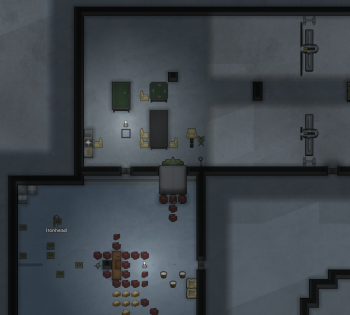
Seventh agenda
- Research hydroponics.
- Make a greenhouse.
- Research biofuel refining.
- Research gun turrets.
Notes
You are on your fourth year and have yet to plant something, so you start wondering if you even need to plant anything at all.
A greenhouse will require a lot of power, which means you will have to defend a larger area to put extra wind turbines. You will also want to add a lot more batteries to store power at night so it may be used during the day. Make sure that your greenhouse is as small as possible to take less power and covered by double walls to increase insulation.
The greenhouse will allow you to stop buying food to survive and stop the cannibalism. Of course, it will also allow you to have more colonists. But first, you should plant some healroot so you can harvest organs without using good medicine. Also, plant smokeleaf and psychoid plant so you can make smokeleaf joints and psychite tea to reduce the overall stress in your colony. Then you may plant some food.
Without the cannibalism you may turn your human meat into chemfuel. Then you can use chemfuel powered generators during winter and solar generators during other seasons.
You are getting wealthy and the raiders know it. Eventually, the turrets you get from quests will not be enough, so you better research them so you can make more of them by yourself.
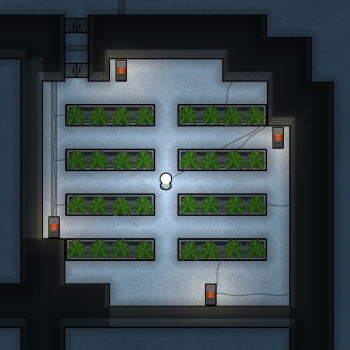
Eighth agenda
- Research and build a long-range mineral scanner.
Notes
There is one last thing worth focusing in sea ice. The long-range mineral scanner.
The scanner works normally on sea ice and if you set a colonist to work on it full-time it can pick up locations of minerals faster than you can retrieve it. Which means you can endlessly make quests for minerals to greatly increase the amount of materials available for you to build your base.
However, you should keep in mind that minerals are heavy so you need lots of Muffalos to carry it. Like a whole 8 Muffalos and 6 colonists to mine Uranium. Which is why is better to make it after your greenhouse, because then you can support all the Muffalos you need.
Tenth year
Did your base turned out the way you expected? If your final base turned out like what you wanted from the beginning then you are good at planning.
